61 Creative Small Living Room Ideas to Maximize Style and Space
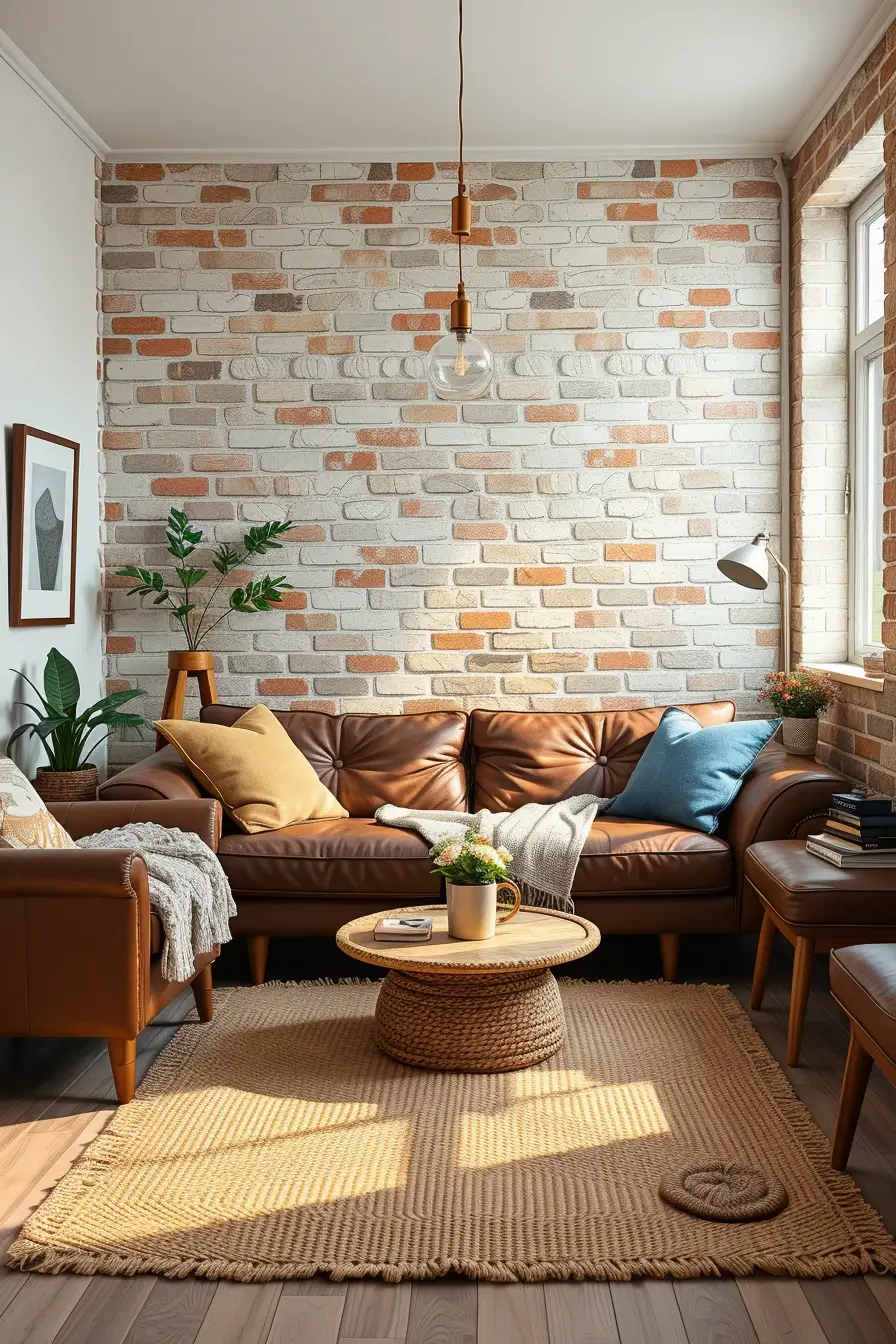
Having problems making the best use of your small living room? Looking for ways to decorate your small living room with style, function and good design? I’ll show you how to use clever ideas in this article to fit everything you have into your small space. Gently open up your space by adding things such as multi-use furniture, mirrors and soft shades and your room will become more stylish and cozy. So, let’s start exploring strategies you can use as early as today.
Maximize Space With Multipurpose Furniture
One way I always like to brighten a small living room is by choosing multipurpose furniture. They take up less space while making life much easier than before. Most pieces in this home are chosen for how well they serve two purposes, whether holding blankets or accommodating visiting guests. You won’t use more space than necessary and your place will remain free of clutter.
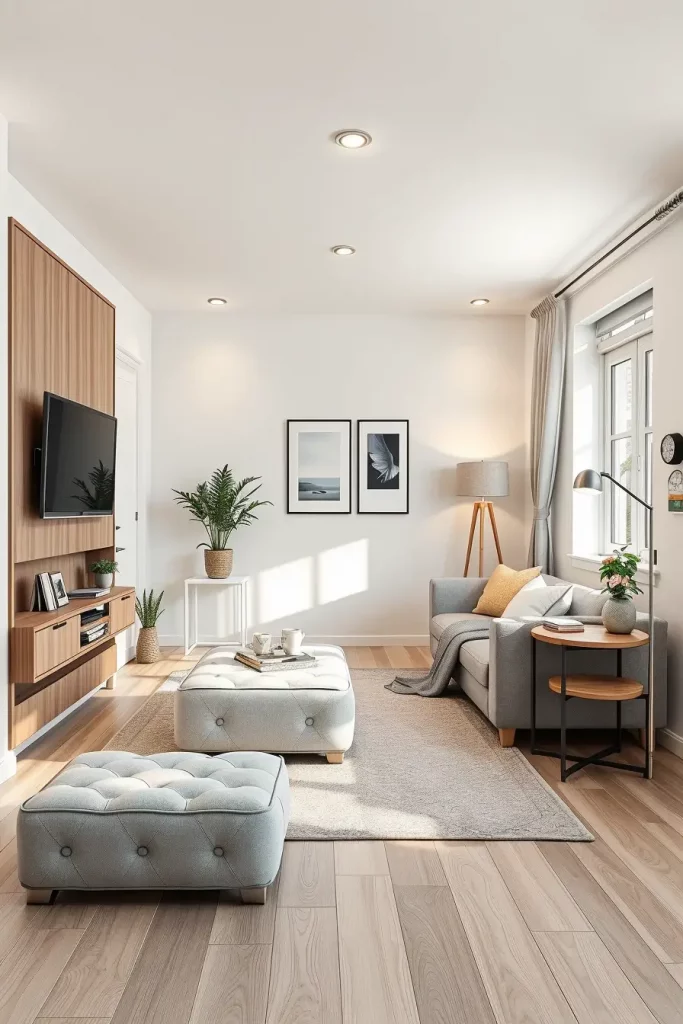
You should always pick items that offer space like nesting tables, desks that can be folded out or coffee tables with hidden space. They are made to perform in places where there is little room around them. A bench that folds open is a good way to add more seating, aside from its storage purpose. You can increase your small space by choosing a media unit that doubles as a bookshelf.
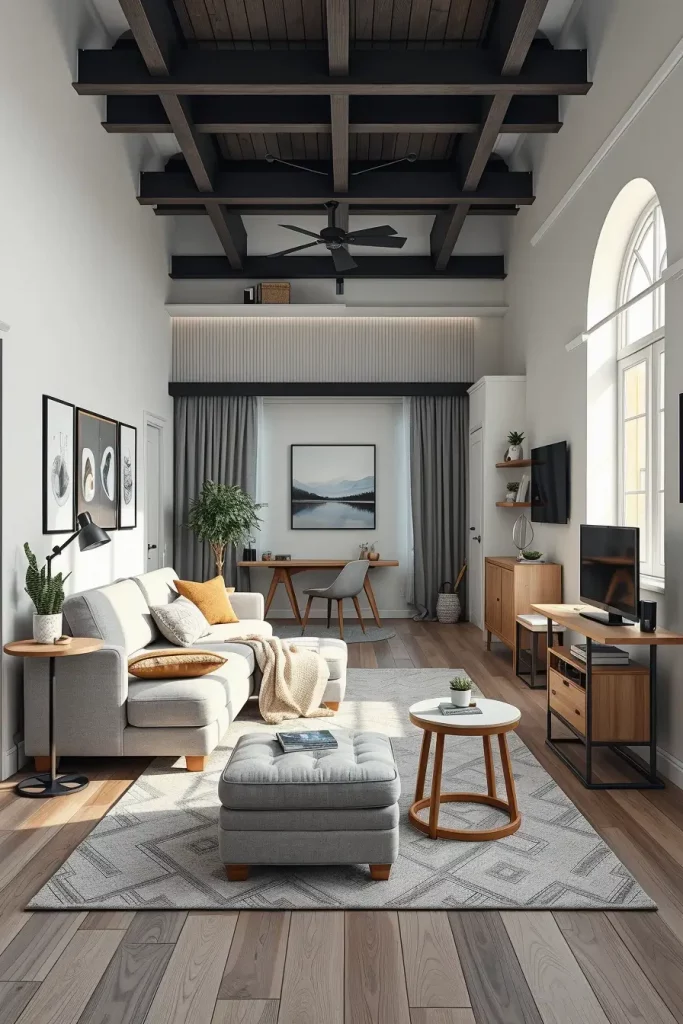
I have found that when a space includes functional furniture, it transforms how pleasant the space feels as well as how it appears. Recently, I helped someone turn their living room into a home office by using a compact folding desk on the wall and making an ottoman the file cabinet. Many times, Architectural Digest stresses that your furniture should fit your lifestyle, no matter how small the space and I completely agree.
Another way to improve this idea is to add a wall bed with shelving so the room can be used in even more ways. In studio-style homes such furnishings allow your living space to serve multiple purposes.
Use Mirrors To Create The Illusion Of Depth
People often overlook mirrors as important tools in interior design and they are particularly helpful in small rooms. One thing I’ve done a lot is use them to open up the space in my living room. Wherever you put them, they let daylight enter and make the space appear larger. This idea does more than improve how a space looks—it can also fill in dark spaces and give more lightness.
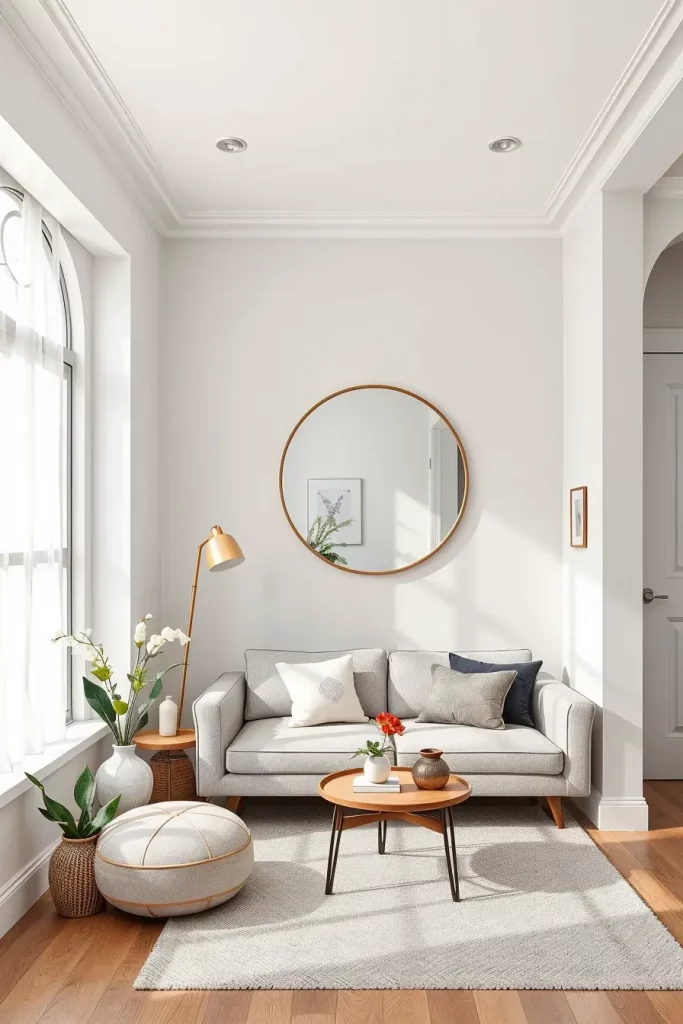
Having wall mirrors, mirrored panels or a mirror console or side cabinet really works for me. They not only make the room look elegant but actually change the space around them. The presence of a round mirror above your sofa or a full-length mirror against the wall can give the room a new ambiance.
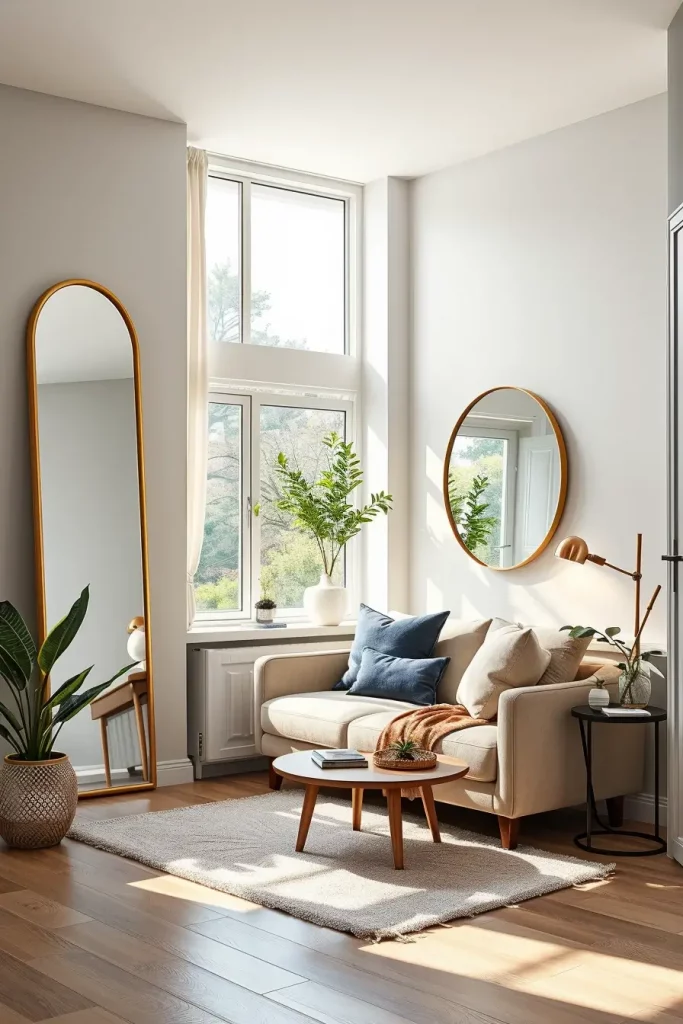
My favorite idea for a gallery wall is a mirror version. Elle Decor’s designer advice is to put mirrors across from windows to fill a space with more natural sunshine and I often follow this tip.
Taking this further, I’d find that a mirror with in-built lighting would be very convenient. Adding a starry ceiling at night will enhance the look and feel of any room.
Floating Shelves For Vertical Storage
When you don’t have a lot of floor space, using vertical shelving is very efficient. Having floating shelves allows you to show your decor without taking up extra floor area—a clear advantage for a small living area. With these shelves, books, plants, art and personal belongings don’t have to clutter up the room.
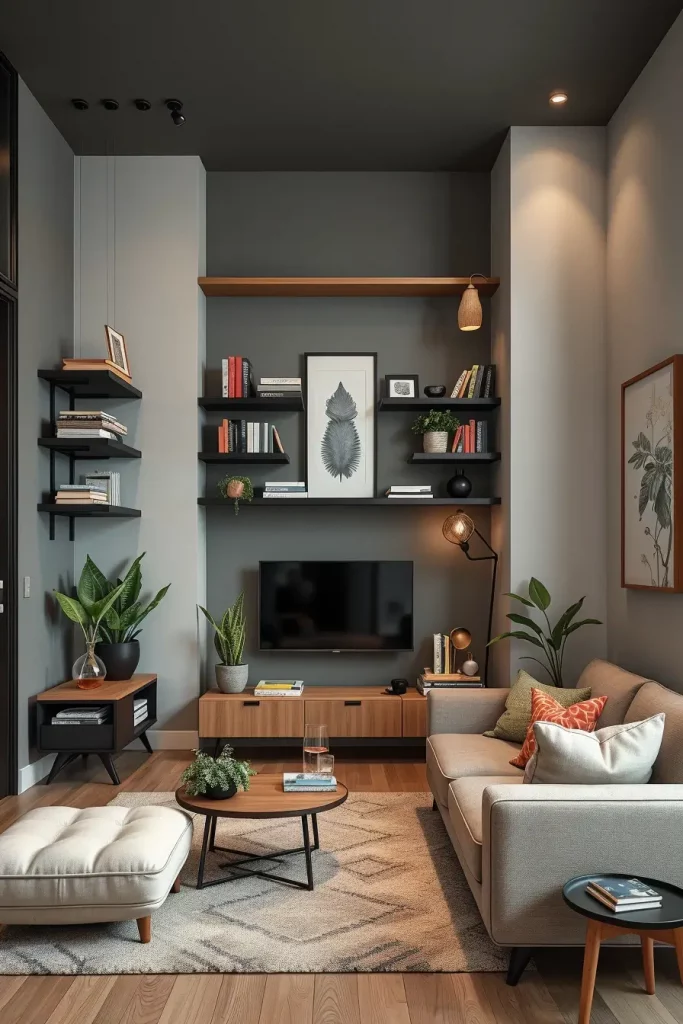
Many of my designs include stacked floating shelves installed on a single accent wall, so homeowners can change how they use them as time goes on. For a Scandinavian room, use hanging shelves in light oak, while a minimalist room might work best with flat black shelves. A corner spot can still work if it’s set up in the right way.
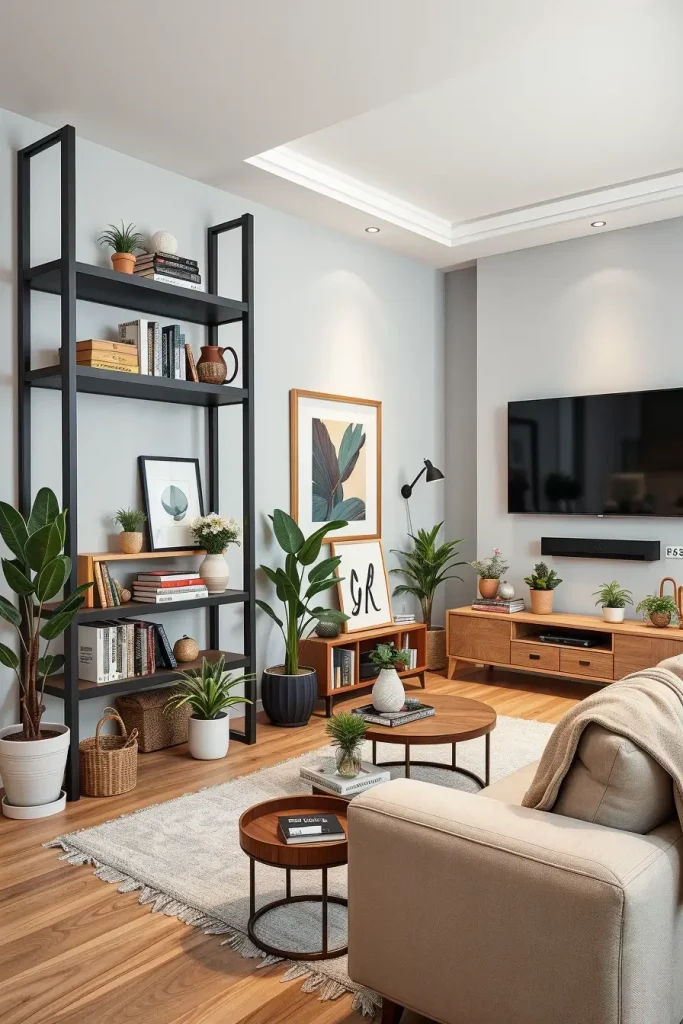
I really enjoy using floating shelves because they are so easy to position. You can put them up easily and it’s quick to switch over to new decorations for each season. I designed a section of one client’s space using books, ivy plants and a few framed prints to form a decorative wall that was useful for storing.
This section could be finished by adding a built-in ladder shelf next to the floating units for extra space to put up decorations and still use available height.
Choose Light Colors To Open Up The Room
Your paint colors can make your small living room space comfortable or uncomfortable. White, soft gray or easy colors help to spread more light, meaning your home seems wider and brighter. I always suggest my clients start by using a simple base and add texture to give the space character.
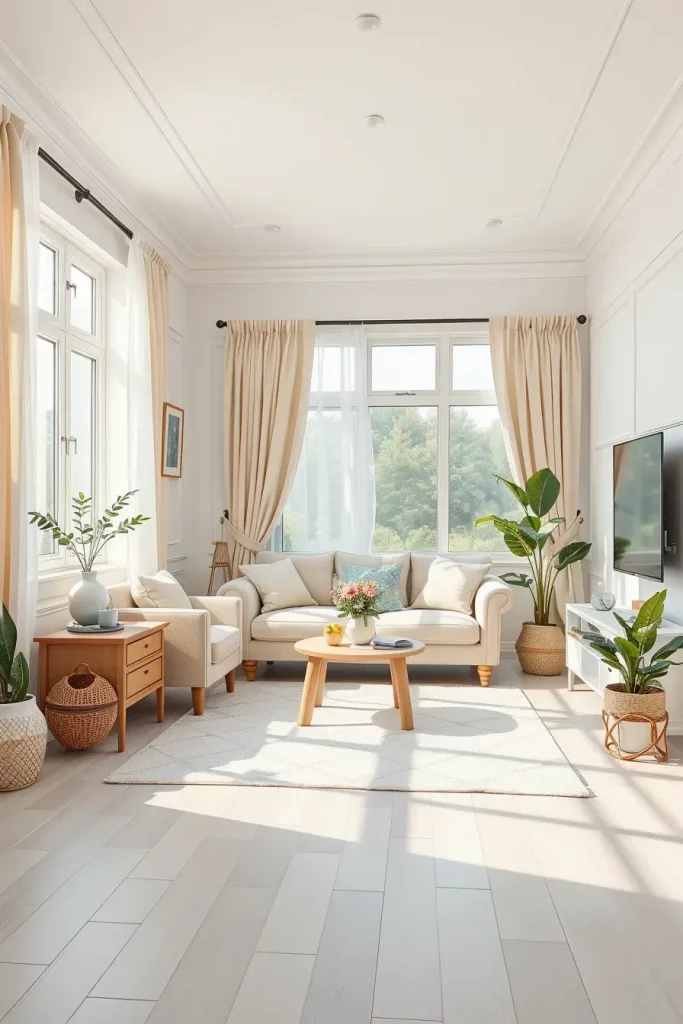
A beige sofa, white or light cream walls and pale wood furniture give off a calming effect and make the room appear much larger. Let light from outside in by placing semi-sheer curtains and choosing light-shaded rugs. Matte finishes minimize the glare of light from furniture.
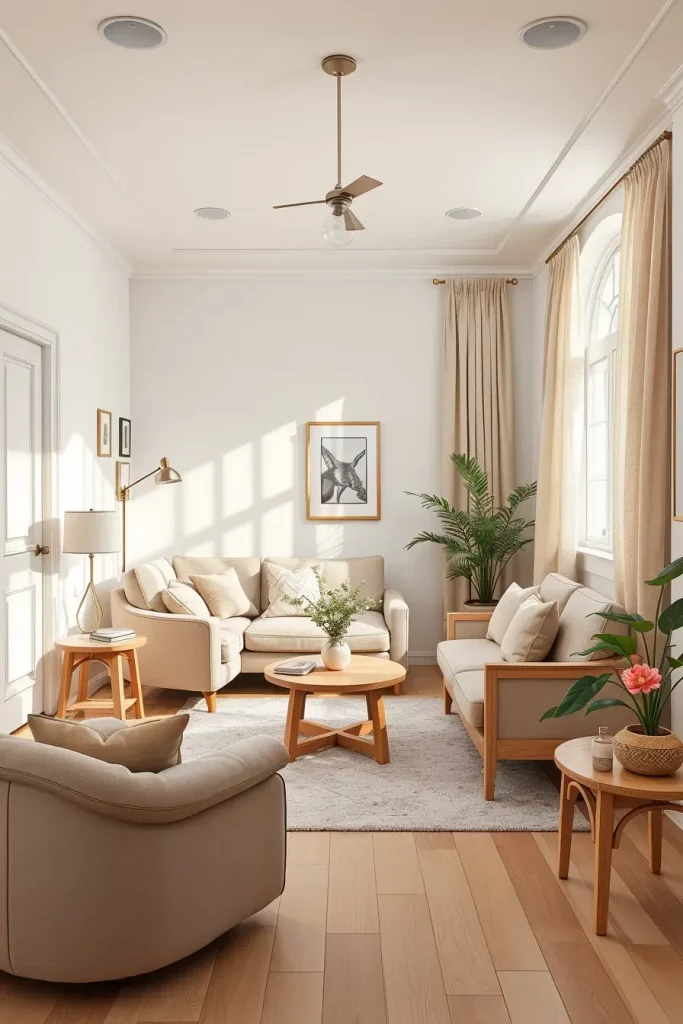
I’ve found that light neutrals allow you to style a room more easily. Real Simple’s interior experts point out that using neutral or white-based colors allows you to be creative with pops of color in your accessories—a thought I very much like.
Another idea is to add a light blue or sage green accent chair so that you can have a bit of color without going too far from the rest of the scheme.
Create A Cozy Vibe With Layered Textiles
You achieve comfort in a little living room by piling together different elements. I add warmth without taking over with layers such as accent pillows, throw blankets and area rugs. Using this approach helps the room look thoughtful and promotes relaxation for users.
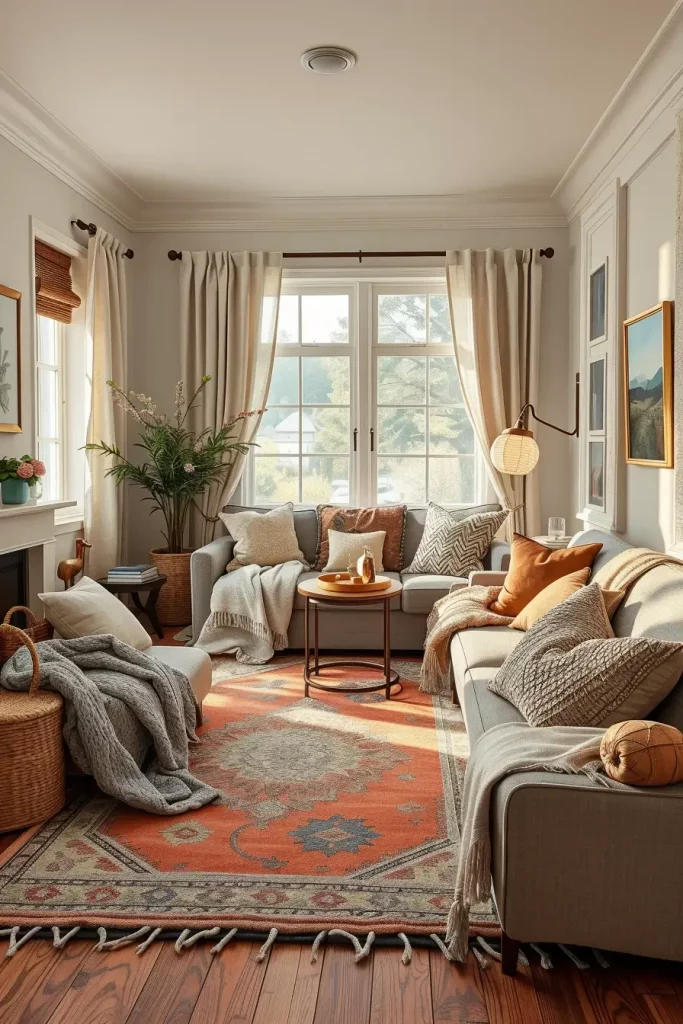
First lay a plain base rug and then layer a charming small rug on that. Align the colors of your pillows and throws to keep the room well connected. Using linen, velvet or a blend of cotton gives your outfits more style options. Even simple fabric wall hangings can add a new flavor to space without using extra floor space.
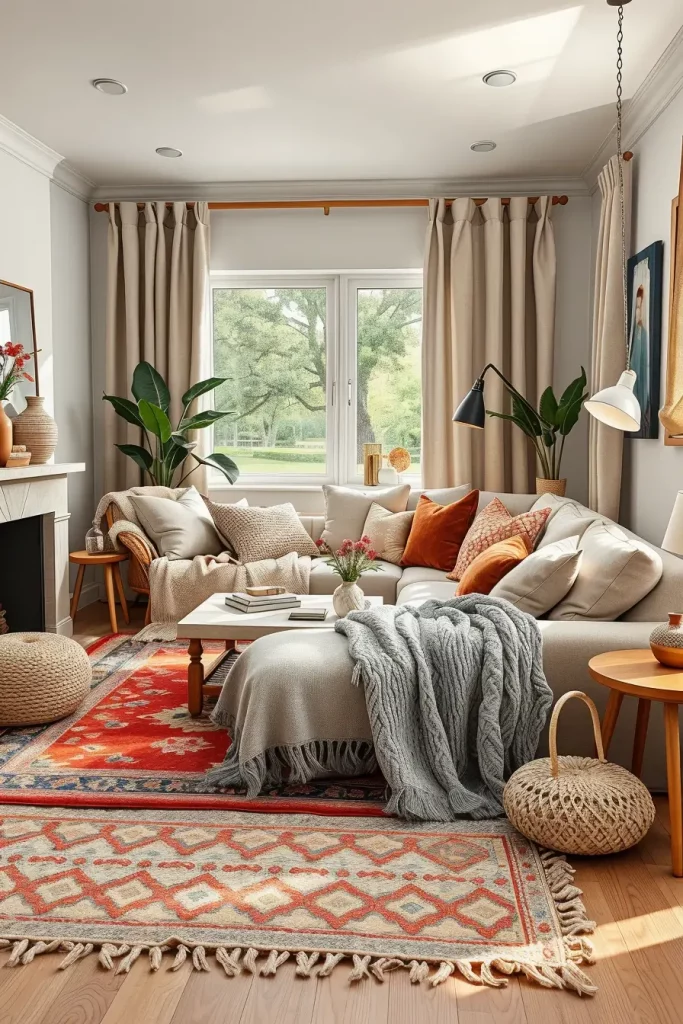
It’s amazing how textile layers can make any room feel more interesting, especially in small spaces. I once participated in making a corner of a room cozier by adding a soft rug, a knit blanket and linen curtains—the whole atmosphere improved.
Something I’d add to further improve this is a pouf or ottoman that is both soft, yet purposeful for every surface.
Modular Sofas That Fit Any Layout
When rooms are small, being flexible can make a big difference. Being able to move their pieces lets you easily adjust your sofa for a small living space. I recommend modular seating because it adapts to daily needs—whether you’re entertaining guests or lounging solo.
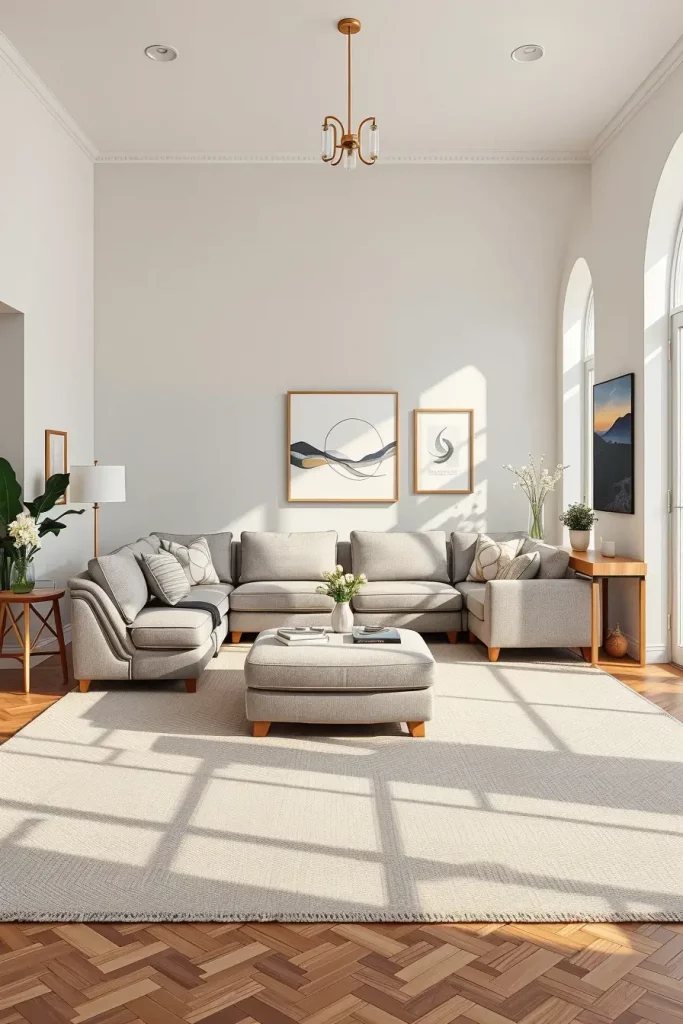
Choose sectional sofas that feature ottomans you can move and backs you can alter. You can change a two-piece modular set from an L-shape into a loveseat whenever you wish. For strength and style, try picking up performance linen or microfiber in dull shades.

I have personally resorted to modular pieces to make the most of layouts with strange corner angles. They serve well for anyone who needs to take their art from one rental to another. Apartment Therapy’s designers often suggest furniture that grows alongside your preferences and this type does just that.
Part of finishing this design is including behind the sofa a console table which allows you to use it without it looking bulky.
Add Personality With Statement Wall Art
Having a strong focal point can really improve a small space. That’s why I usually hang statement wall art to add both personality and interest to the space. There’s no better way to give your small living room a personal touch without using too much space.
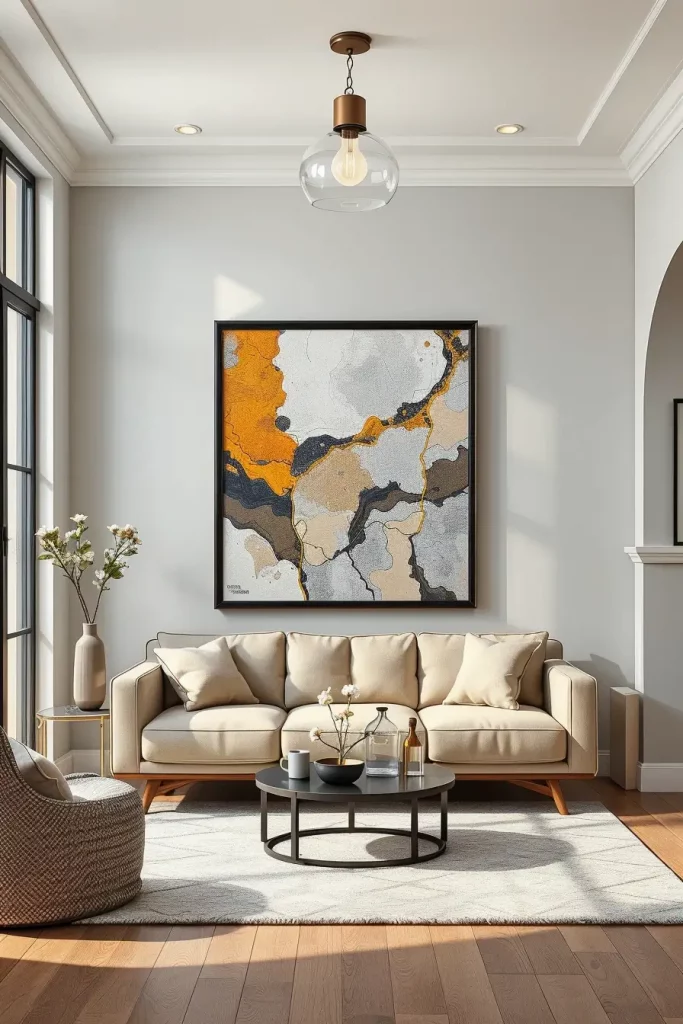
Try putting up a big canvas, choosing a graphic print one or even having a few related prints together to avoid clutter. Light wood or matte black frames design allow you to appreciate the artwork without distraction. You could also try using floating frames for a current look.
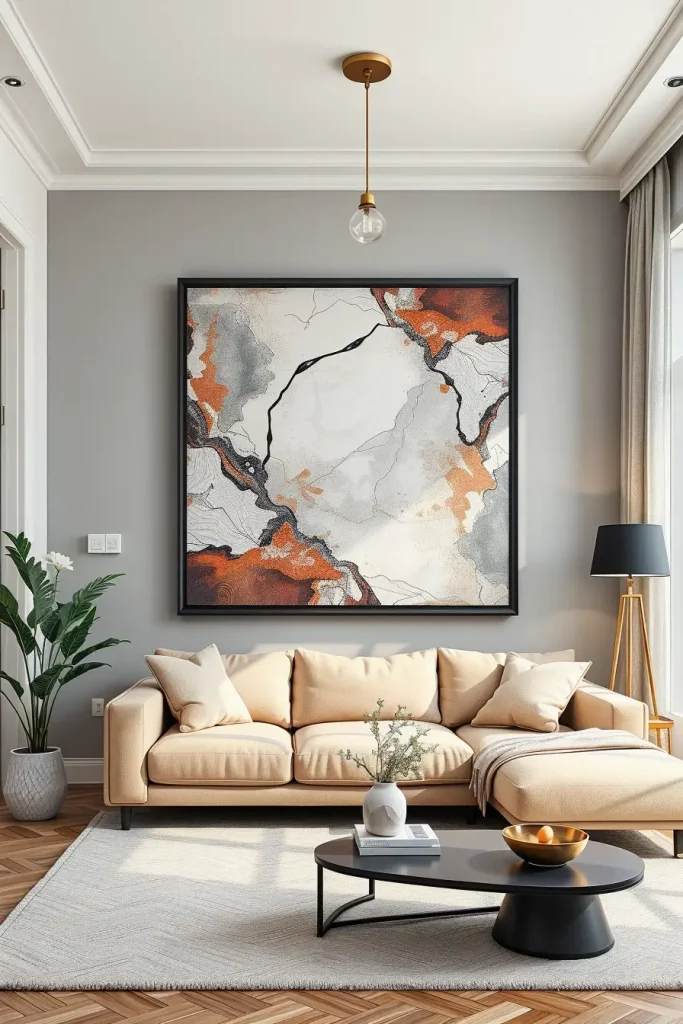
I’ve noticed that a standout piece can truly change the atmosphere in a space. I had a black-and-white abstract work placed behind a neutral sofa and it was the most visible part of the room. According to interior designers at House Beautiful, using artwork helps unify the look in your home.
Adding a picture light above the art or a throw that matches the color palette, would give the wall more interest.
Space-Saving Coffee Tables With Storage
I design small living rooms by often adding storage in the form of coffee tables. Thanks to these, you can tuck remotes, magazines or blankets inside them to keep your home clear from clutter. In small-scale environments, every detail counts and using furniture that serves two functions makes both your area and your furniture more appealing.
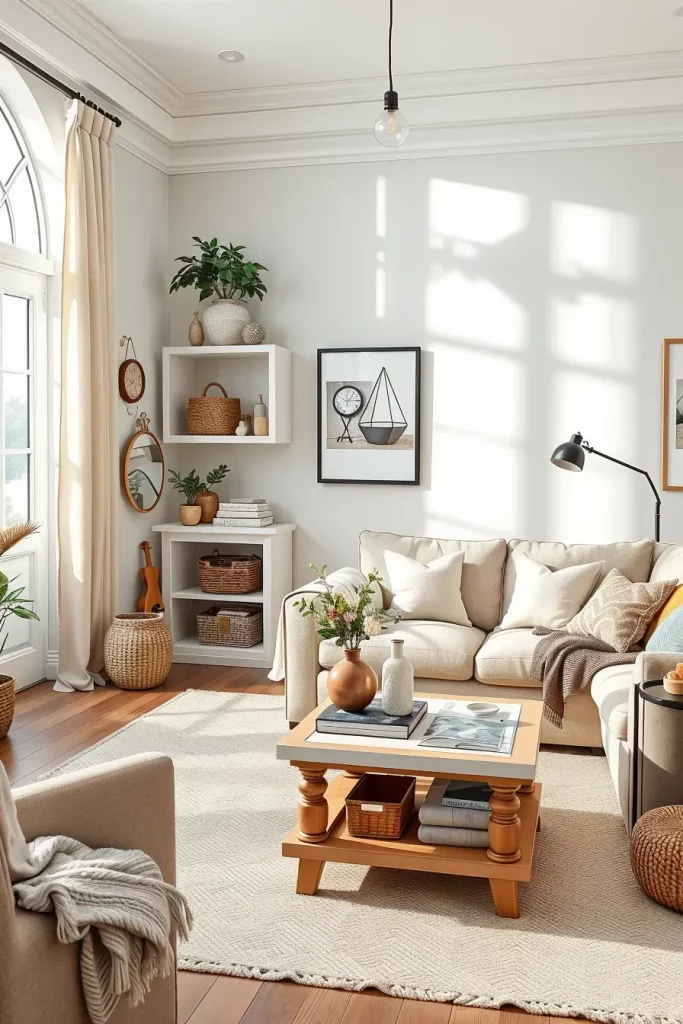
I often advise getting a lift-top model, as these tables have secret storage and can be used for either working or eating. A number of these units feature open shelves underneath that are handy for books or attractive baskets. If you have space for two sets, choosing a round table and two sets of nested stools is a nice choice too.
I have personally included a lift-top white-washed wood table in a design for a city apartment. The clients were very happy to find that a simple swap in furniture made their space look so much better. HGTV’s experts say that multi-purpose coffee tables are extremely popular in urban homes.
I’d make the design complete by adding a matching storage bench on one wall to add both function and more balance to the room.
Go Bold With A Feature Accent Wall
Creating an accent wall using bold colors is an a great idea for spicing up a small living area. Well-chosen art work helps center a room and adds variety to plain walls. My advice for a dull or boring room is often to add a gallery wall.
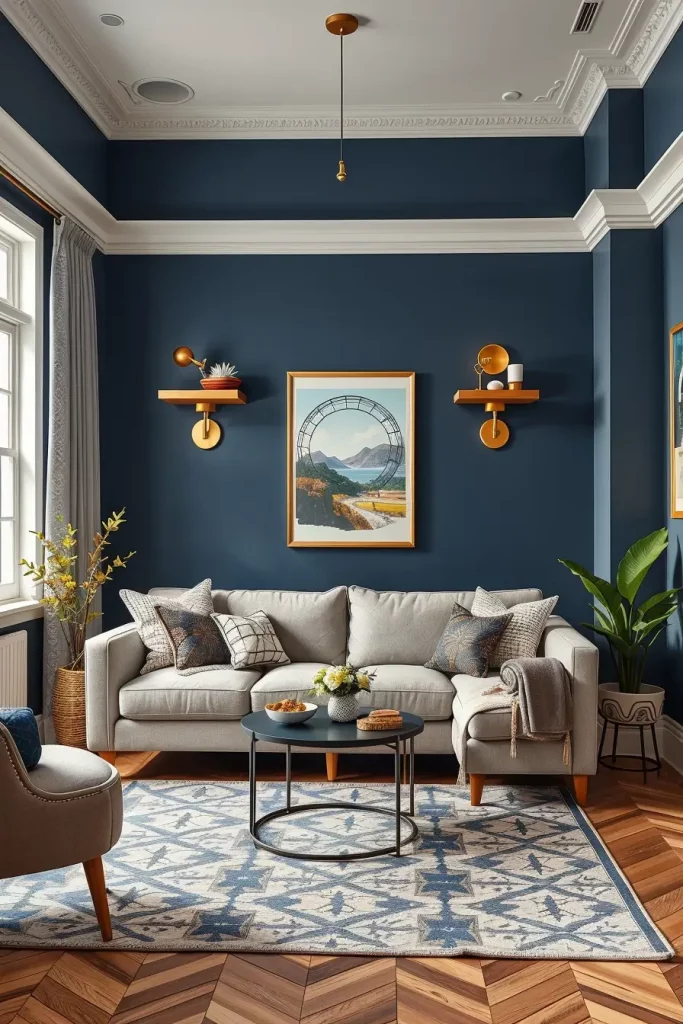
In some cases, I would advise picking a navy blue, a sage green or a rich reddish-brown color. Choosing geometric wallpaper or wood slat paneling can give a wall an even richer appearance. The wall you highlight should automatically grab the eye of anyone who enters, for example the wall behind where your sofa or TV unit is located.

A compact area was completely transformed for me by choosing a matte charcoal wall, hanging oak shelves from the ceiling and adding brass. It made the room more beautiful, but didn’t make it feel cluttered. Interior designer Nate Berkus says that bold walls can display your style even in cramped rooms.
An accent pillow or rug in the same color as your chosen accent brings everything together.
Try Minimalist Decor For An Airy Feel
When people are after an airy, uncluttered feel, I always suggest using minimalist decor. Since it is simple and easy to arrange, modern minimalism works great in making small living rooms look spacious. You should choose a few items that are of high quality and enjoy having them stand out.
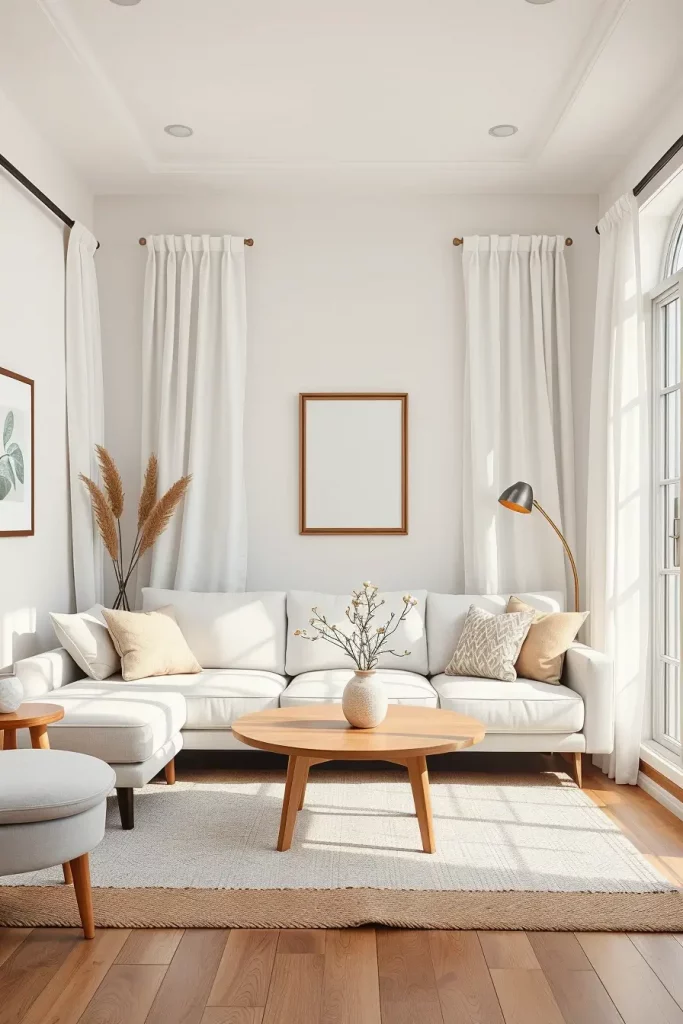
Choose tidy lines, simple colors and uncomplicated furniture, for example a sofa that sits low, a classic round coffee table and a sculpture or vase that carries special meaning. Stick to plain textiles and wall art and let the sunlight and details in your space do the talking.
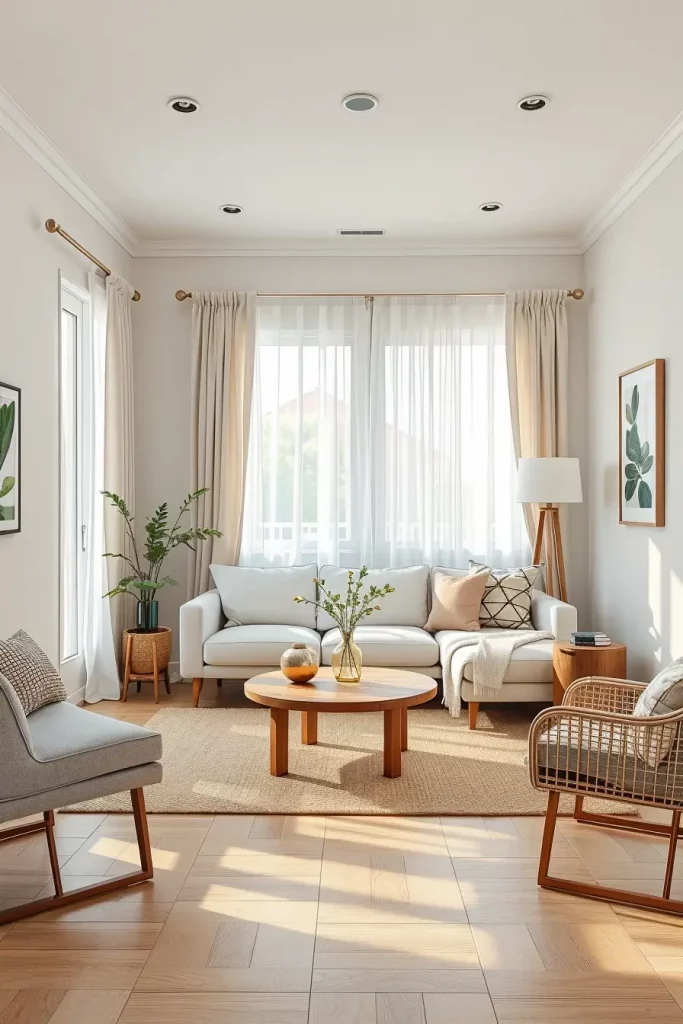
I don’t think that embracing minimalism requires your room to seem bare. Just four furniture pieces and some sheer curtains were enough to give this client’s room a spa vibe. Everything came together wonderfully and everything was at peace. Dwell magazine points out that going minimal can both calm your surroundings and make your lifestyle more simple.
Last, introducing just one indoor plant, for example, a snake plant or ZZ plant, will add some freshness while staying orderly.
Utilize Window Nooks Creatively
Many homeowners ignore window nooks in their living room, but these spaces are very useful. If you’re fortunate to have one, it can be used for cozy reading, keeping your things safe or as a place for people to sit. I always look at these spots as creative opportunities to extend the room’s functionality.
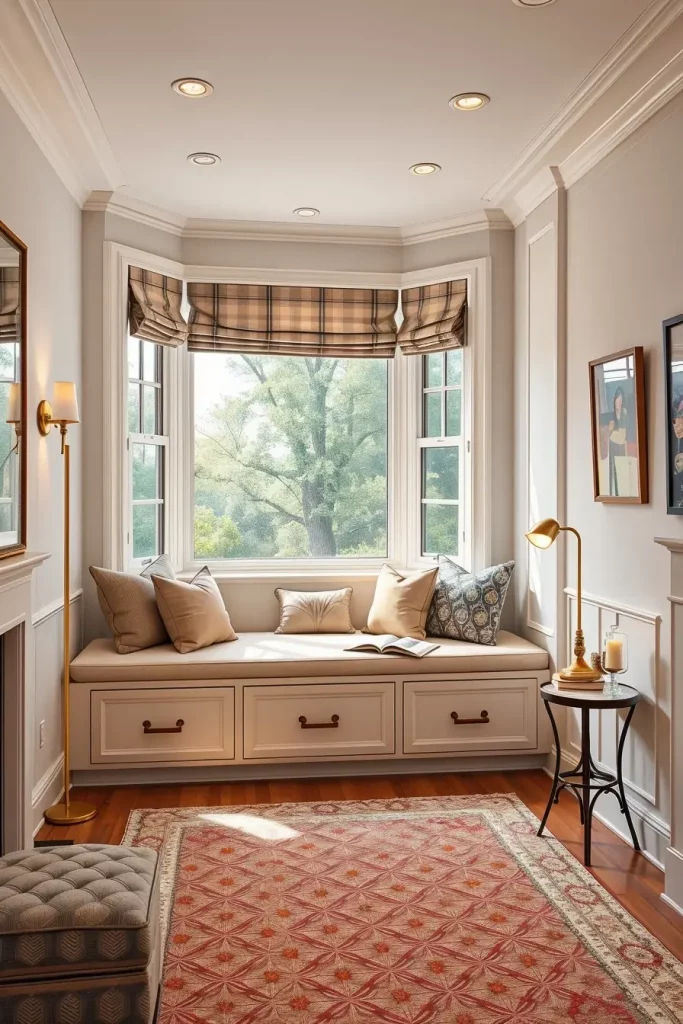
A custom bench seat with built-in drawers underneath the window area is what I have created. Add some comfort to your seating by including cushions and many pillows and finish it with drapes or Roman shades. Having space for a narrow side table helps this become an excellent area to read.
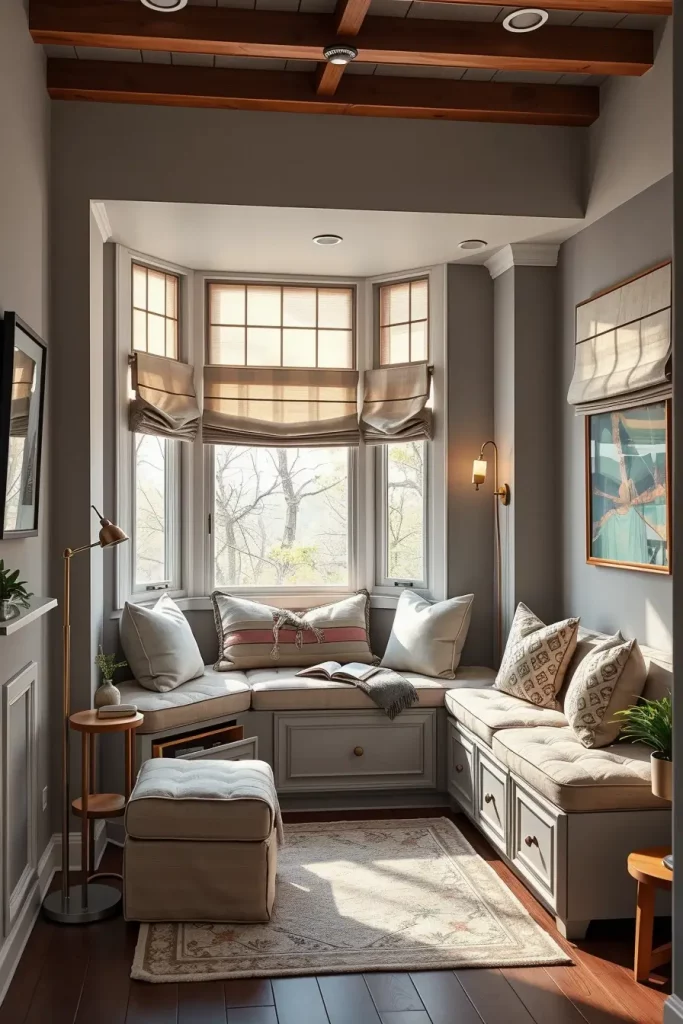
One client hired me to take their bay window and convert it into a breakfast area where their kids could play. The seat cushion I could wash and the bins made everything more practical. Emily Henderson often points out that window seats can be designed for any use.
Another way to improve this nook is to put up a wall-mounted lamp or reading light this way and also include a wall shelf for books or a Bluetooth speaker.
Opt For Wall-Mounted Lighting Fixtures
In a small space, floor and surface space is at a premium and wall-mounted lights are a lovely way to save it. I prefer slim sconces or swiveling arm lights to brighten a small living area more efficiently, instead of using clunkier furnished lamps or standing lights.
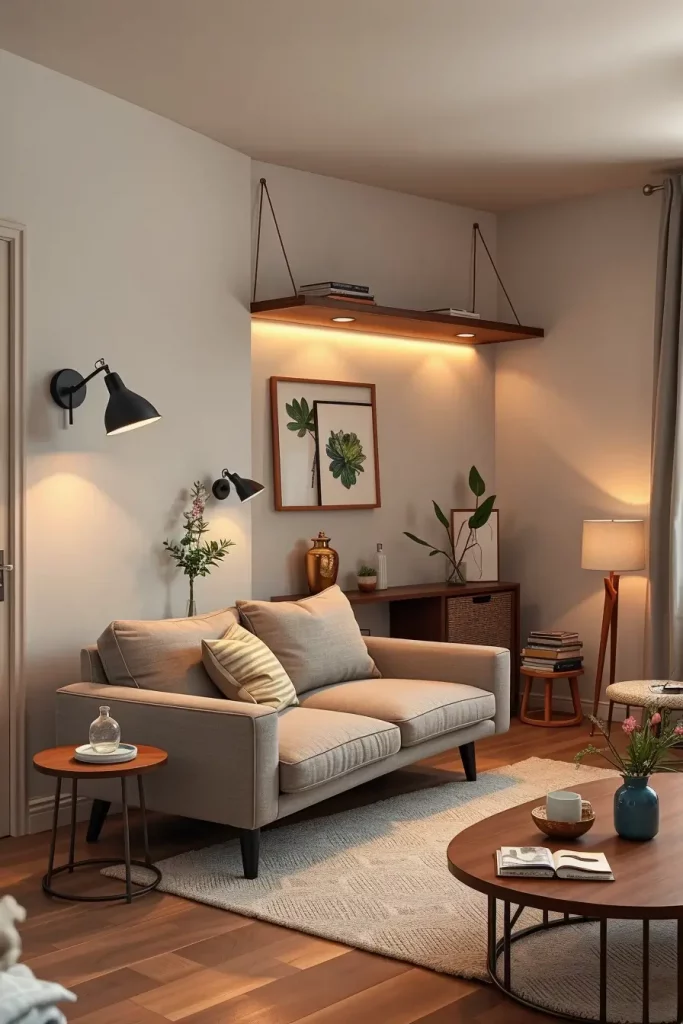
No matter if your sconces are modern or look vintage and let you switch the arm, you get focused light on the wall without using floor area. Picture lights can go above a sofa, next to a mirror or above the side table. A lot of these models just plug in and do not have to be hardwired.
I have relied on this approach in apartments with limited space everywhere. Putting table lamps away and choosing wall lighting allowed us to use open decor and keep all the surfaces clean. Smartly placed lighting is a tip that Domino magazine’s design experts often remind readers about for small spaces.
The process is almost finished; I’d then add a shelf below the lights for more use—great for holding keys, books or even candles.
Create Zones In Open-Plan Spaces
Separating areas is very important for small open-plan spaces. It helps to set up a system that makes sense and works well in a website. I typically change the design slightly by moving rugs, arranging furniture and updating the lighting wherever needed for seating, dining or working.
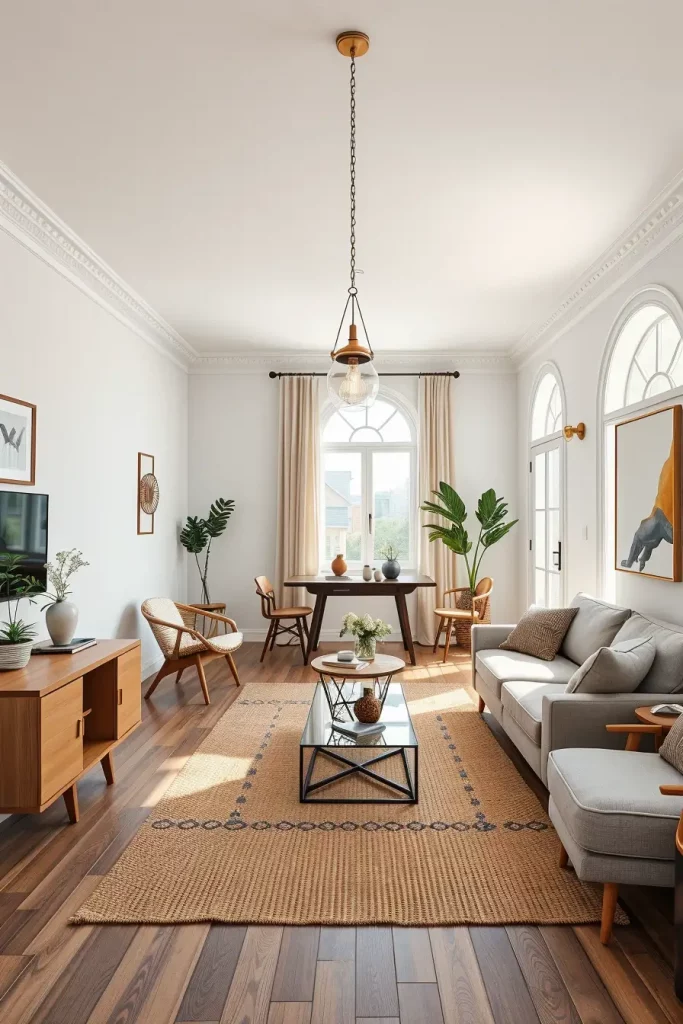
Lay a distinct rug in each zone and set the furniture so it points toward the inside of the space. Sliding your sofa away from the table can help create two distinct spaces. Putting a low bookshelf or console table between areas gives a purpose but helps keep the area airy.
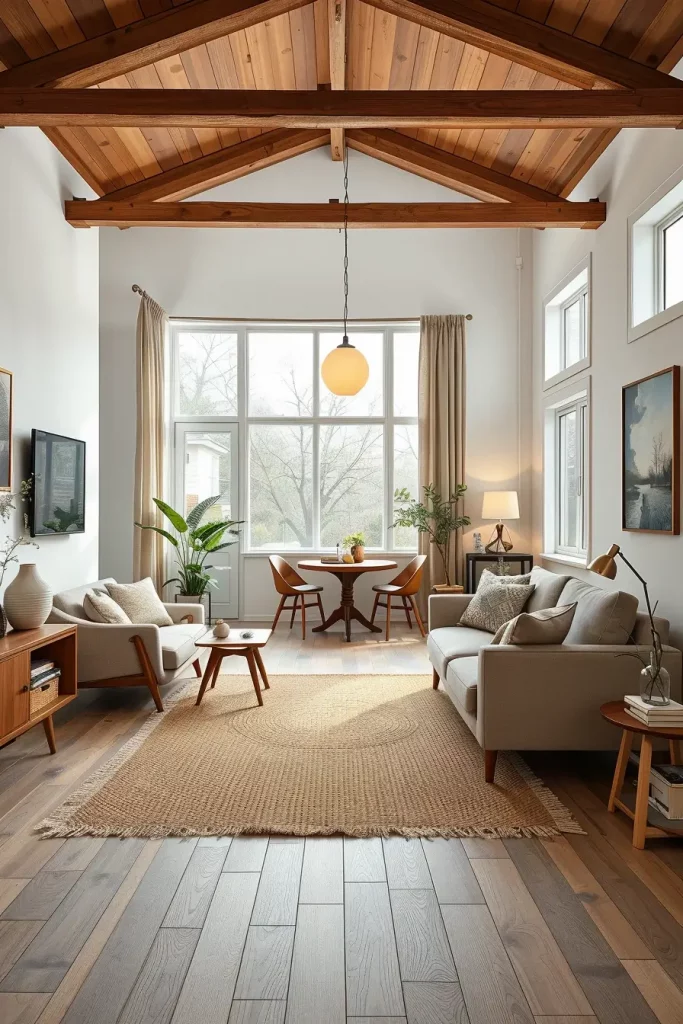
I separated the living-dining area in one project using a large jute rug and a pendant light set above the dining table. Immediately, the two separate areas were created, distinctly marked by furnishings rather than any real walls. Open-plan design uses this strategy as a basic tactic, Better Homes & Gardens explains.
I’d make the zone strategy better by placing a rotating TV mount in the middle so it can be seen from both the living and dining areas without the need for a second TV.
Use Rugs To Define Areas
Rugs offer much more than style; I like to use them to help outline different areas in a small living space. They can help keep furniture secure, direct people around a room and set apart sections in an open space. Environmentally, this simple thing can make a huge difference.
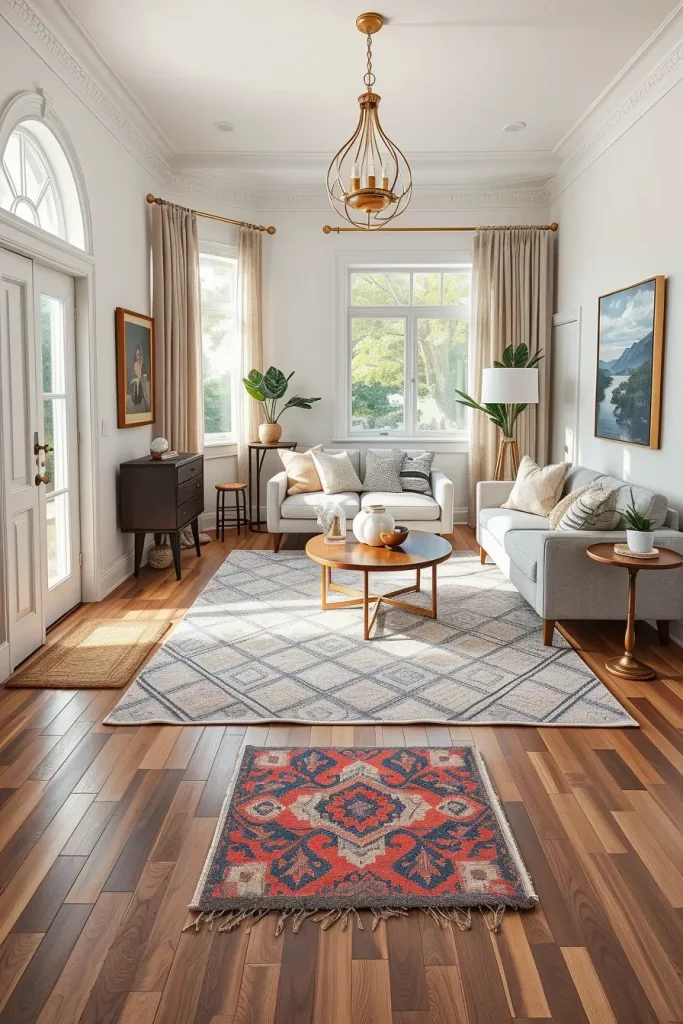
Find a rug that is big enough to reach just below the front legs on your sofa and matching chairs. In rooms without walls, place diverse rugs in each area to indicate what’s where. If your space is minimal, a soft-pattern rug will fit the theme, but if you like eclectic styles, choose one with bold patterns.
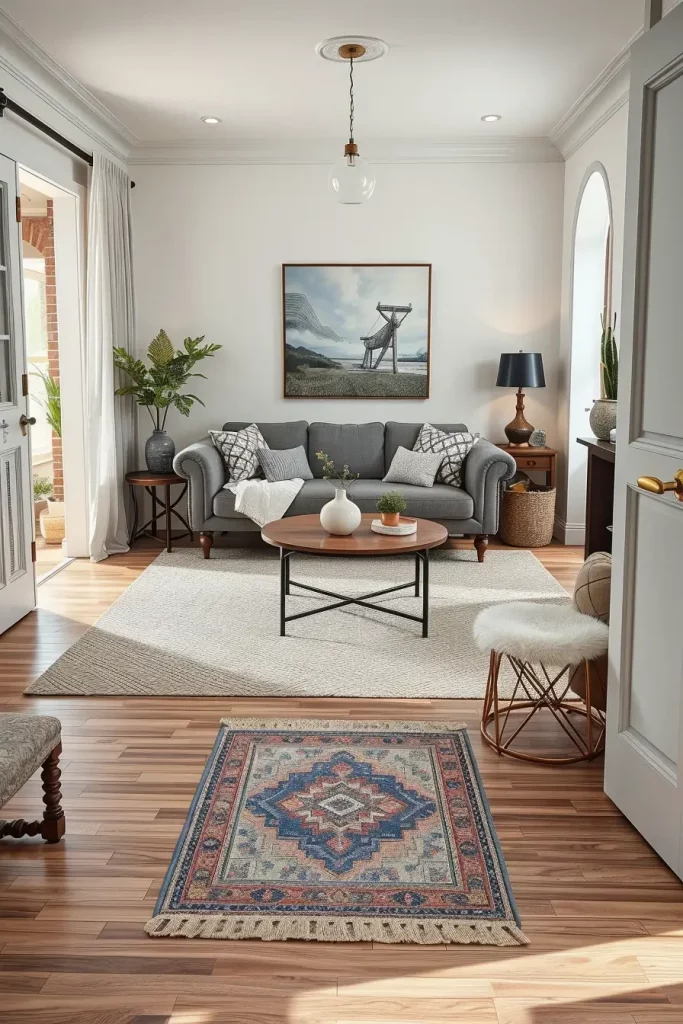
I usually say rugs create the baseline for any room. I supported a pair living in a 350-square-foot apartment in making their place feel bigger by putting a thick rug under modular furniture. West Elm designers consider rugs to be the main way to define zones in spaces where several activities happen.
For an even look, you might place a round rug near the door or under your coffee table.
Add Greenery With Hanging Planters
One easy and effective suggestion for a small living space is to put up hanging plants. Where floorspace is limited, using vertical design is very important. With planters hanging from the ceiling, the beauty and action they add remains in the room and doesn’t take up floor or surface space.
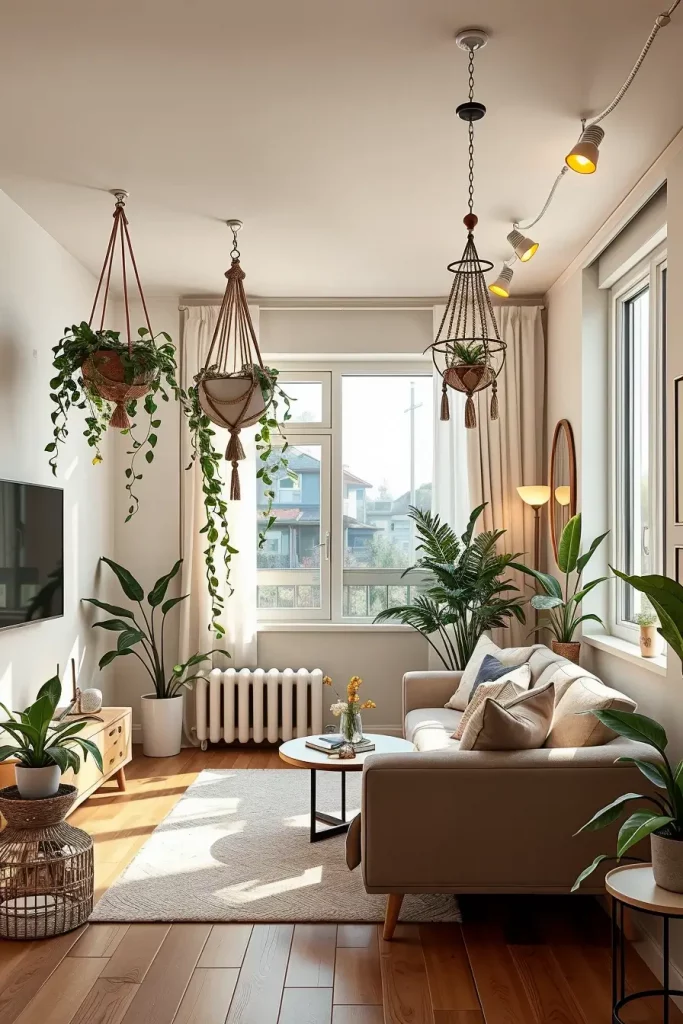
I enjoy suspending hanging pots of trailing plants like pothos or ivy by way of macrame hangers or metal ceilings frames. If you have bright indoor lighting, try putting up spider plants or philodendrons. They complement the hard edges of your home’s interior by making things seem more homely.
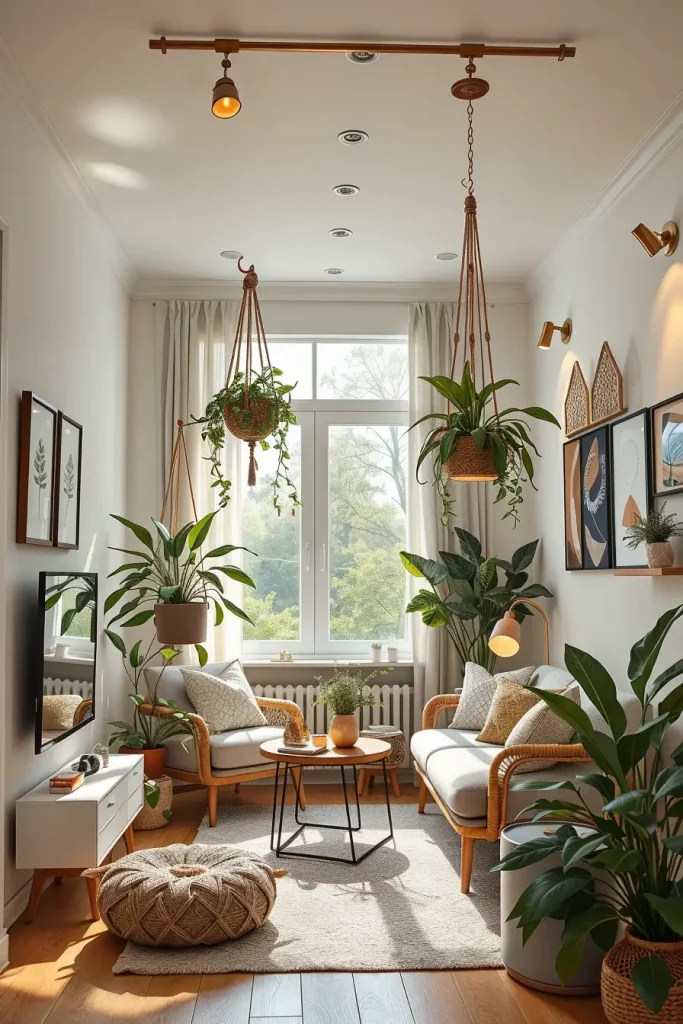
I notice that having plants makes me feel better and makes a little space more welcoming. Architectural Digest has published science that shows that having indoor plants can relax you and brighten the air around you.
It’s commonly overlooked to have underlighting or spotlights that draw attention to the greenery at night. Directing a warm LED spotlight at the plant can improve its appearance and keep it eye-catching once it’s dark outside.
Foldable Furniture For Maximum Flexibility
Planning for narrow or compact rooms means that folding furniture is more than just a good idea; it’s necessary. If some furnishings can collapse, slide or be stowed away, the living room can be used in many ways. The philosophy behind this concept is to clear up area without sacrificing enjoyable or practical use.
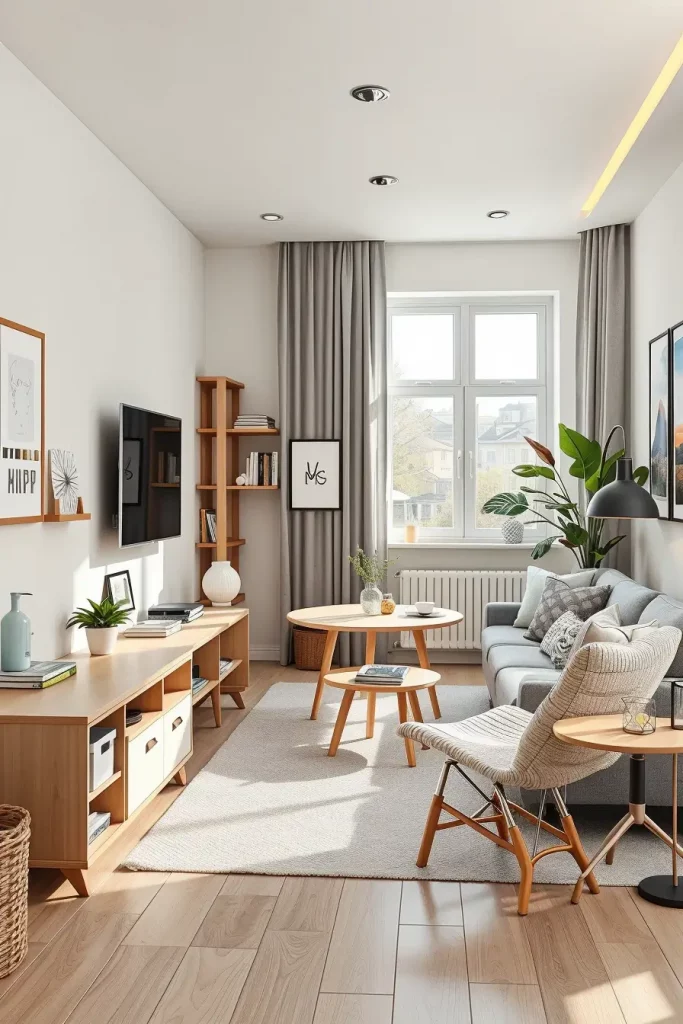
I like adding things like folding desks, extendable coffee tables or benches that can be used as cubes for storage. When you are low on space, a Murphy chair or a folding table can be used for dining, so the living room can double as the dining room.
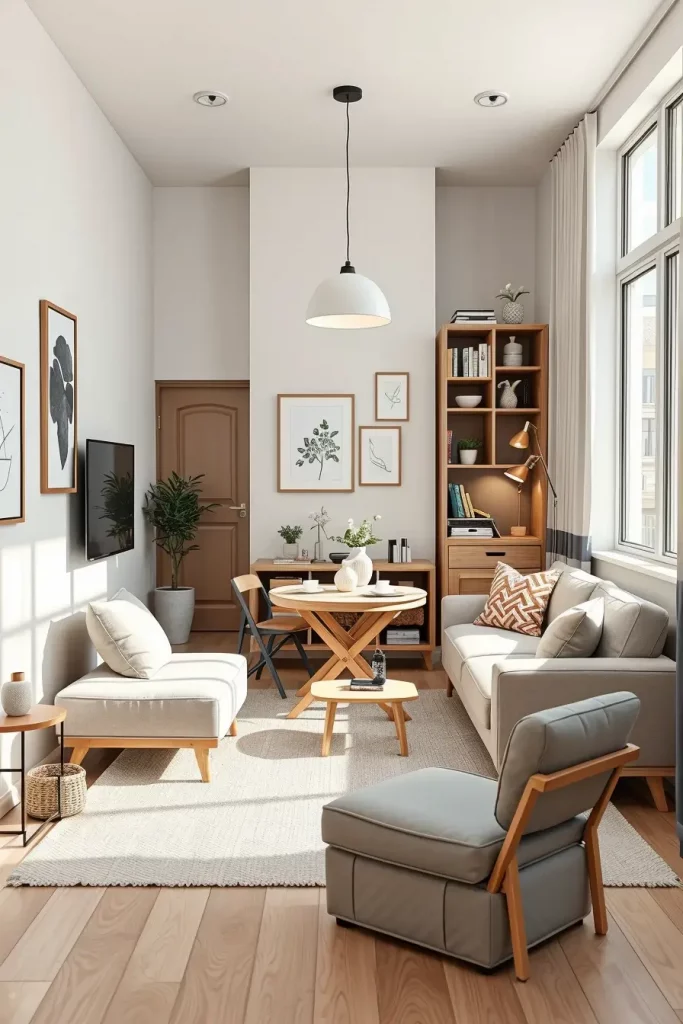
Using multipurpose pieces from brands such as IKEA or Wayfair gives your living room much more flexibility. According to Elle Decor, being flexible helps you achieve great interior design in smaller spaces.
One thing that’s often forgotten is having the foldable furniture match the overall design. Using the right colors and materials will make the TV seem part of the room when it is not being watched.
Create A Focal Point With A Gallery Wall
Gallery walls are a fun way to add your own touch to your small living room. A unique wall design can be the central focus which means you do not need plenty of large furniture or artwork, so it fits nicely in small spaces.
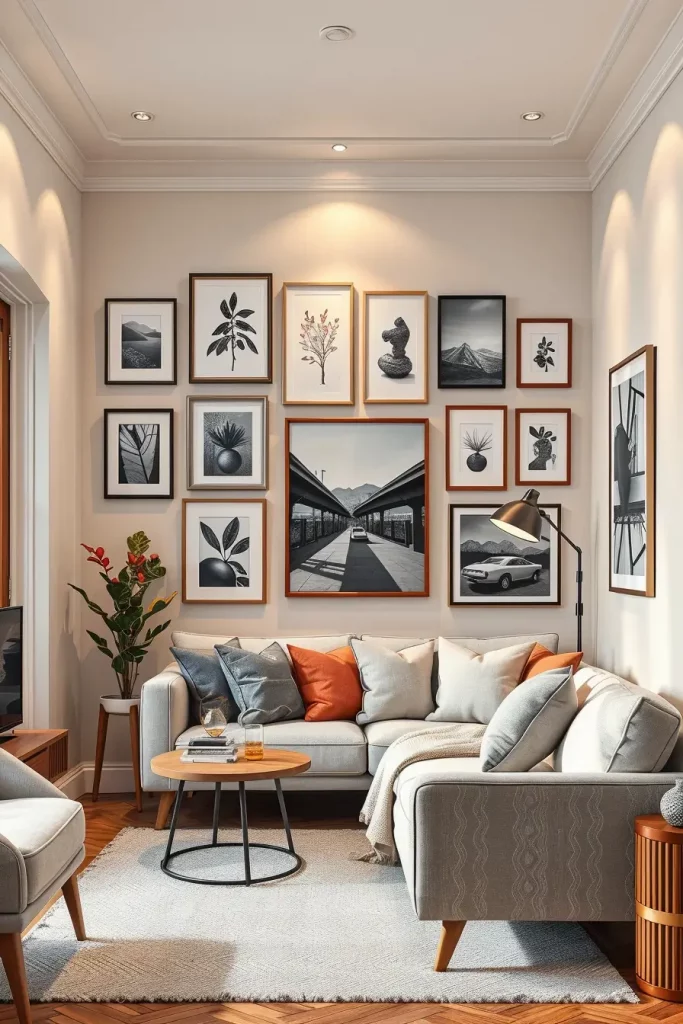
It’s good to use different frame sizes, styles and themes. Select artwork all in the same style such as black and white or abstract pieces, to give your wall display uniformity. Place your central pieces first and then work your way out for balance within the whole room.
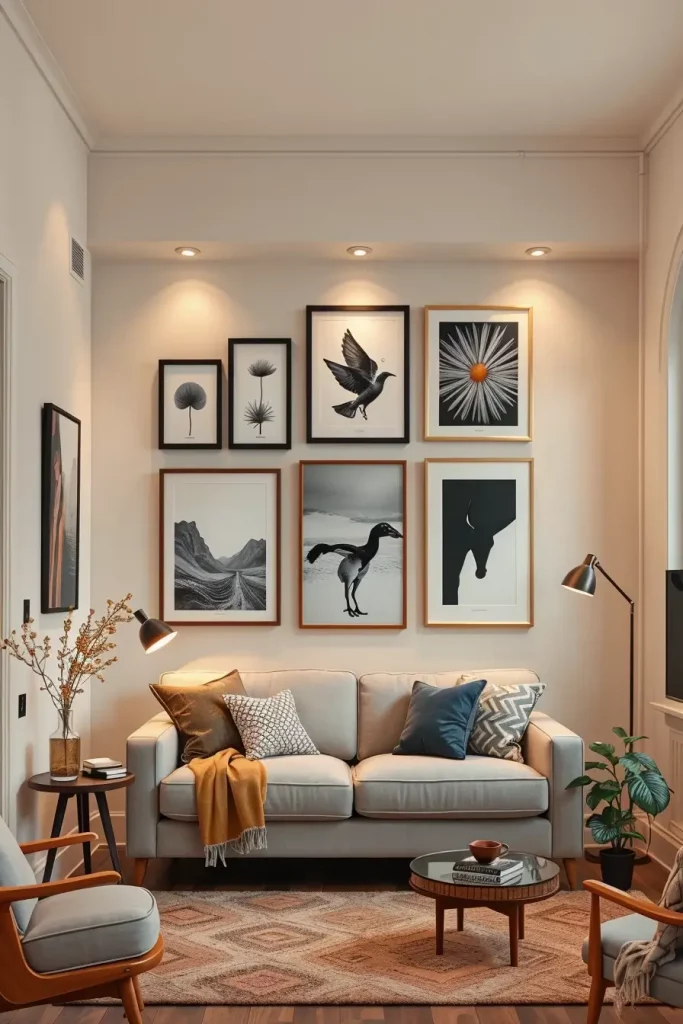
Personally, hanging a gallery wall above a small sofa or console made the room look much better. The magazine House Beautiful mentions that a gallery wall can give your room a special and meaningful feel.
Many times, the lighting isn’t right for the occasion. Try emitting light upwards from the bottom of your artwork with picture lights or track lighting, so your living room looks like a stylish gallery.
Play With Contrasting Textures
An easy way to liven up a little space is to combine different textures. Often, a simple neutral color scheme makes a small room feel one-dimensional, but using textured décor can create a warmer feel without introducing bright tones.

I prefer to bring together perfectly smooth leather seats, comfy chunky knit throws, elegant velvet cushions and a woven jute rug. A wall with texture or even a single brick wall can quickly make any room appear more appealing.
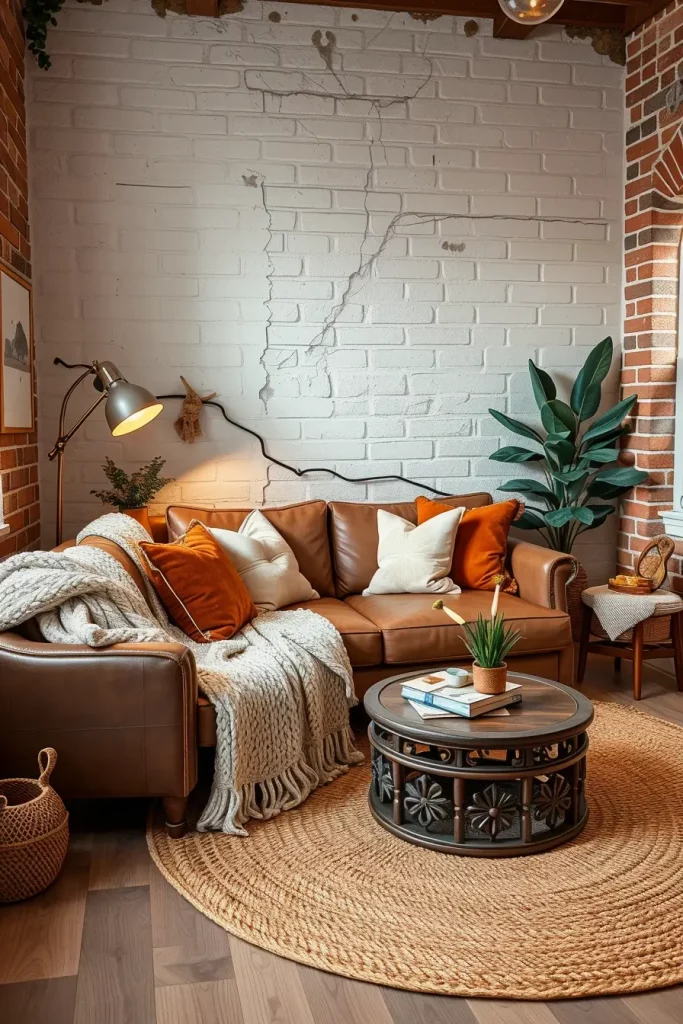
In my opinion, adding different materials to your textiles makes the room look alive and cozy. Dwell Magazine reports that putting texture in your interior design can make a small home more visually appealing and interesting.
What’s missing? A combination of surfaces on the ceiling or around the windows. This look can also be used in every part of the space using painted wood trim or coffered details.
Use Curtains To Soften Hard Edges
Besides light control, curtains gently soften any harsh lines in a small living area. It helps join the sharp features and smooth transitions among wall, windows and furniture, thus adding harmony to your room.
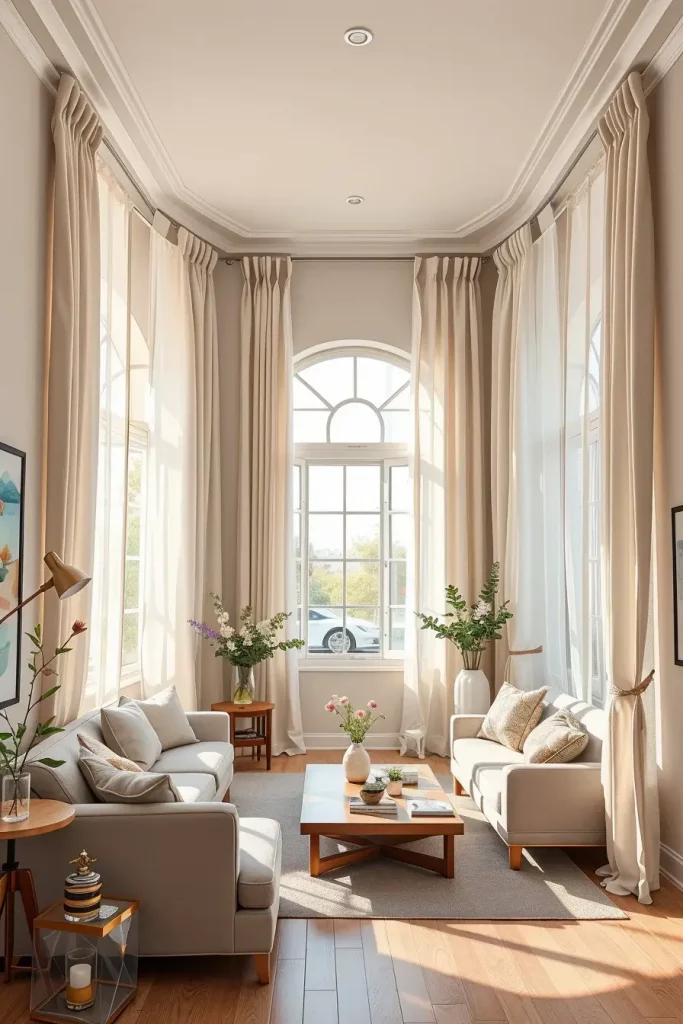
Even for small windows, I recommend hanging sheer curtains that go from the ceiling to the floor. The slope of the hallway pulls the ceiling up, making the room look more open and less enclosed. You can use light beige or grey together to create a nice match for your décor.
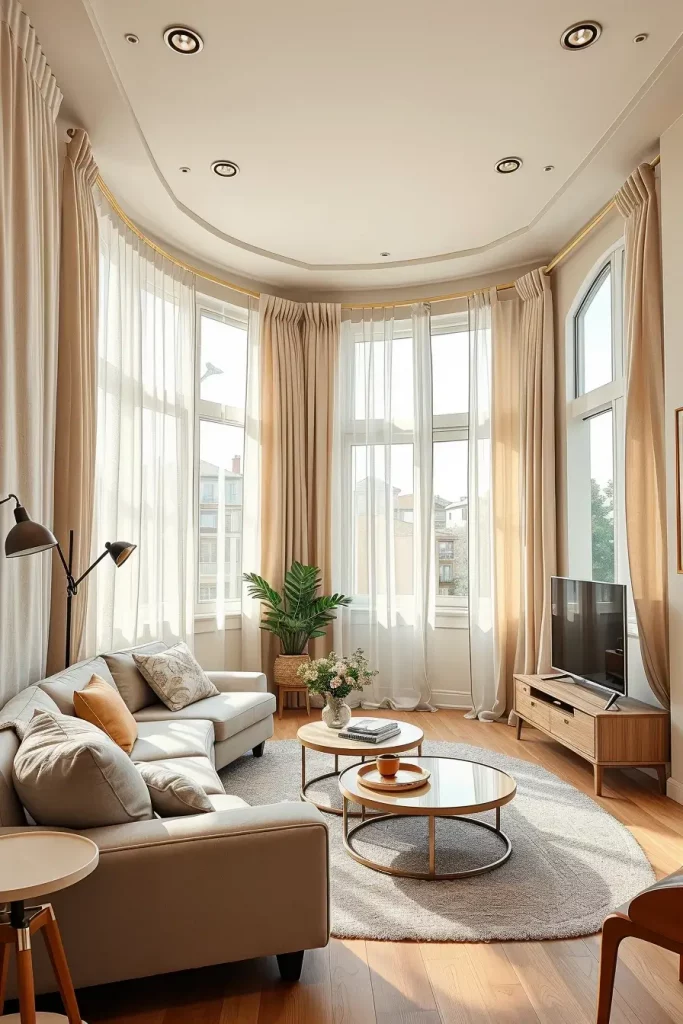
Linen curtains in my home make the space feel calmer and downplay some of the main architectural parts around them. Many times, Emily Henderson recommends light and airy window coverings to soften contemporary spaces.
Much of the time, curtain rods are not used properly in interior design. Widen the curtains a few inches past the front of the window to make it seem wider and to let more sunshine in.
Smart Storage Ottomans And Benches
Placing storage ottomans and benches is a clever way to use space in a small living room. Because of their folding abilities, these pieces add storage space and also act as seating or tables which is perfect for small spaces.
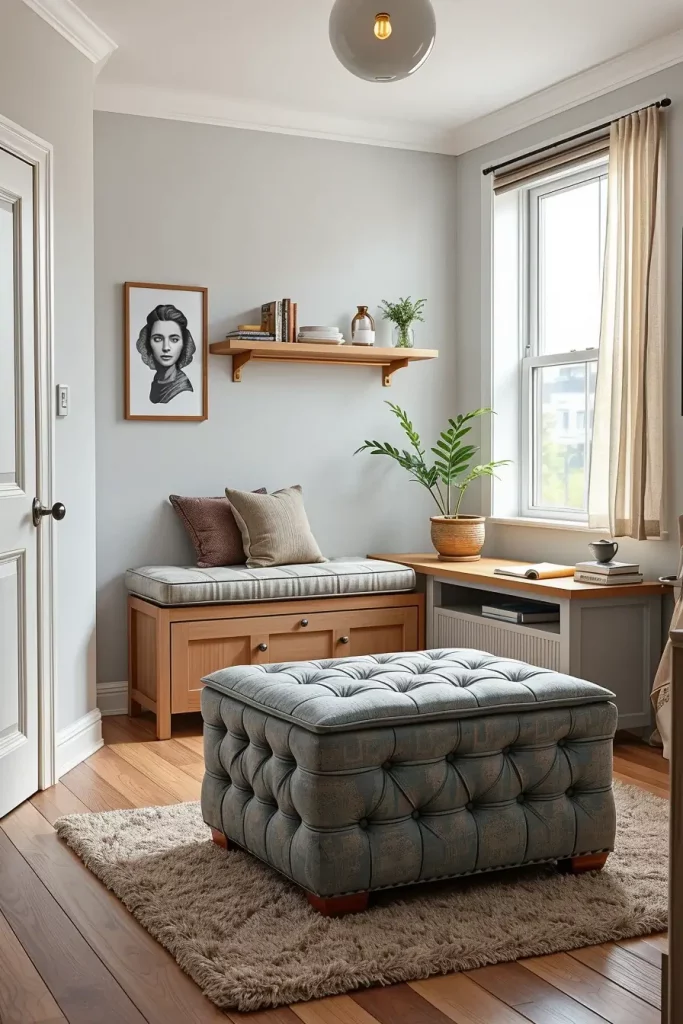
It’s great to use an ottoman with hidden storage for keeping magazines, remotes and seasonal wools. You could create both practicality and style in your living room by including a flip-up bench seat near the entry or a window.
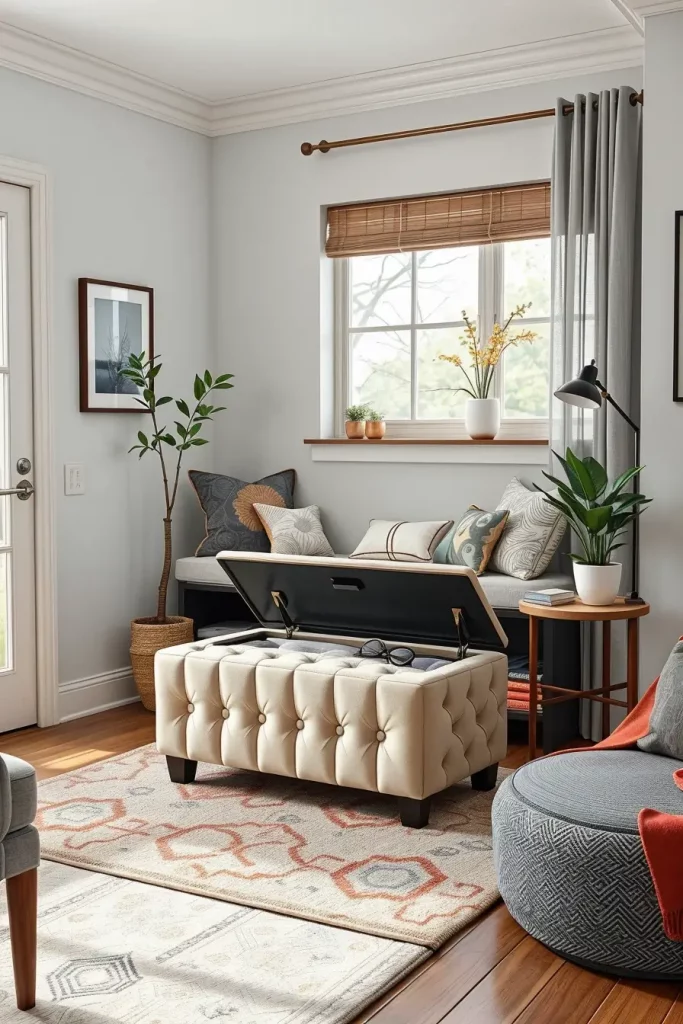
From what I’ve seen, these things make your home look tidy without stealing valuable floor room. According to Real Simple, try to place items in your home that have multiple uses.
We haven’t included tall cabinets above the bench or ottoman in this idea. Having a floating shelf or small cabinet above improves the how the space functions further.
Play With Scale Using Small-Scale Furniture
One mistake I often see is using standard-sized furniture in rooms that can’t handle the visual weight. That’s why you should use small-scale furniture—it helps you fill up the room without making it feel cramped.
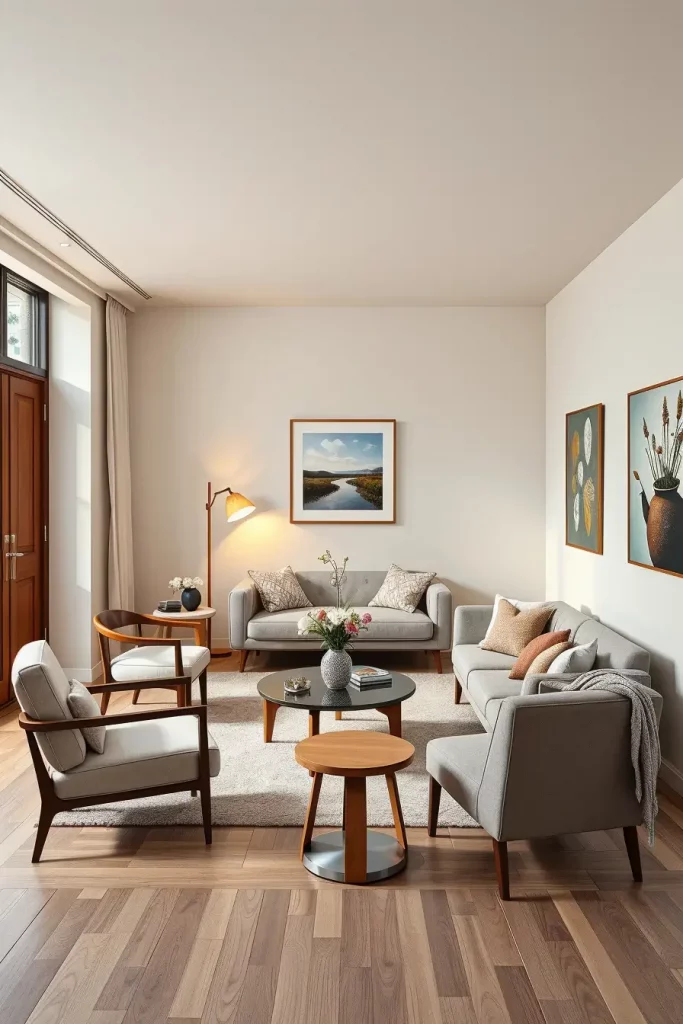
I tend to go for chairs without arms, very slim sofas and tables with open legs. They allow for plenty of visual space and make it easier to get around the home. Pick furniture with smaller backs to fit aesthetically with the scale of the room.
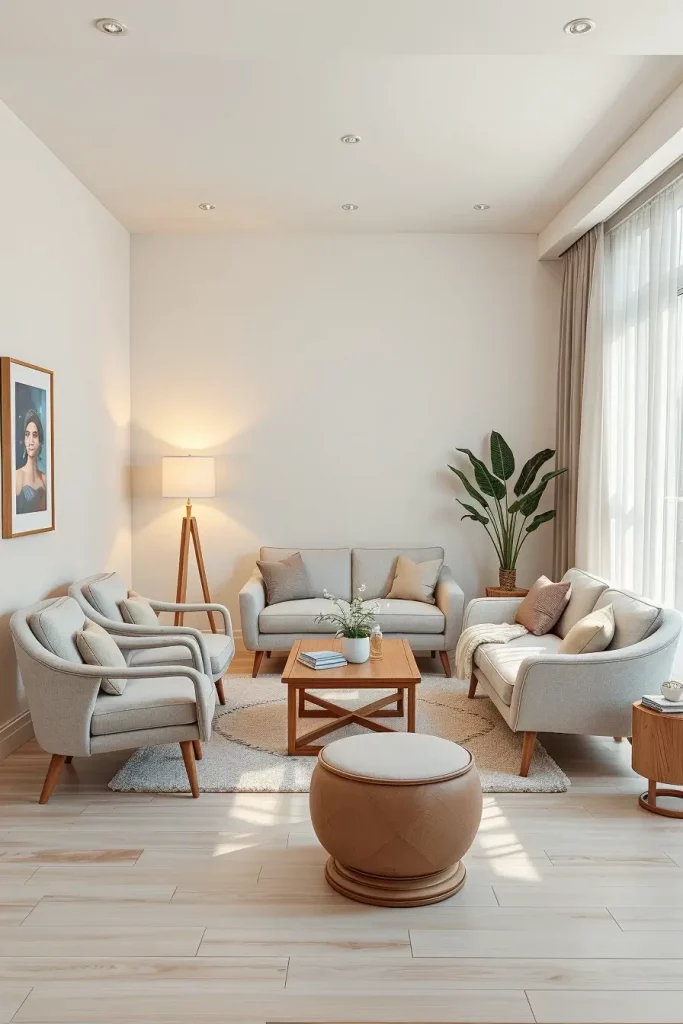
I found that switching to a loveseat over a big couch meant I had free space to put in side tables and a floor lamp. The strategy relies on Better Homes & Gardens guidance that it’s important for small rooms to be proportioned well, rather than filled with lots of items.
One further addition to this section might be a look at furniture that stands on its own or is wall-mounted. Eliminating dressers means creating a more open floor and freeing the eyes of unnecessary visuals.
Go Monochrome For A Streamlined Look
One of the best ways to make a living room feel tidy is to use just one color scheme. When a space is small, it is easier to feel chaotic visual clutter. Having all the shades in the room the same color helps achieve neatness and refinement.
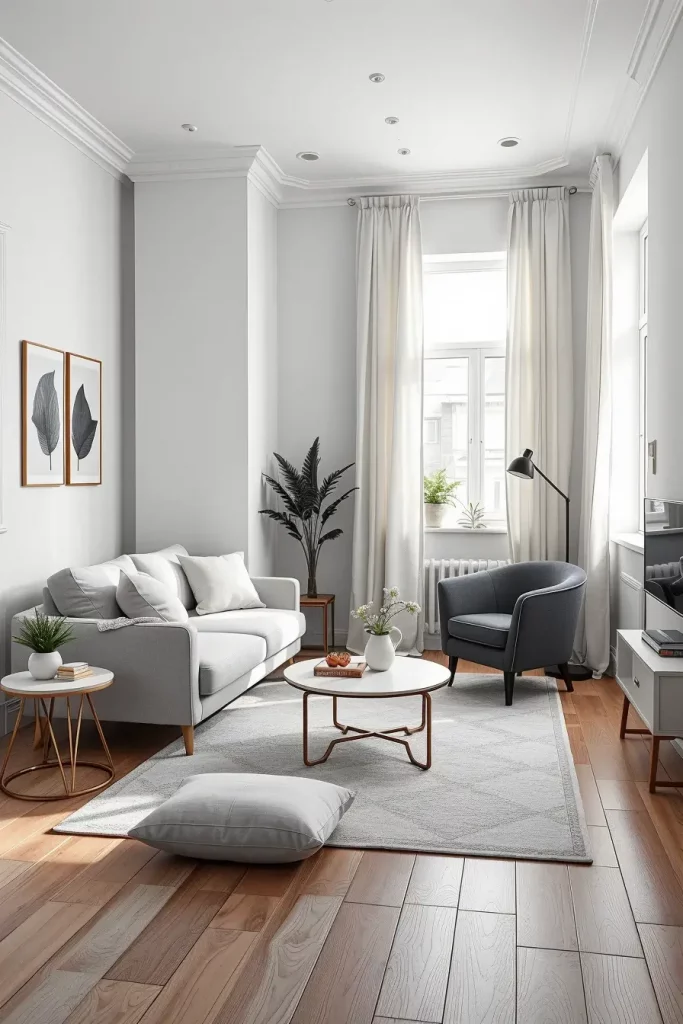
Most of the time, I choose light-toned colors and add a few other shades from the same color category. This could mean adding a soft white sofa, ivory curtain panels, light small gray pillows and an off-white rug. The result is that textures are in focus while the whole interior design is blended.
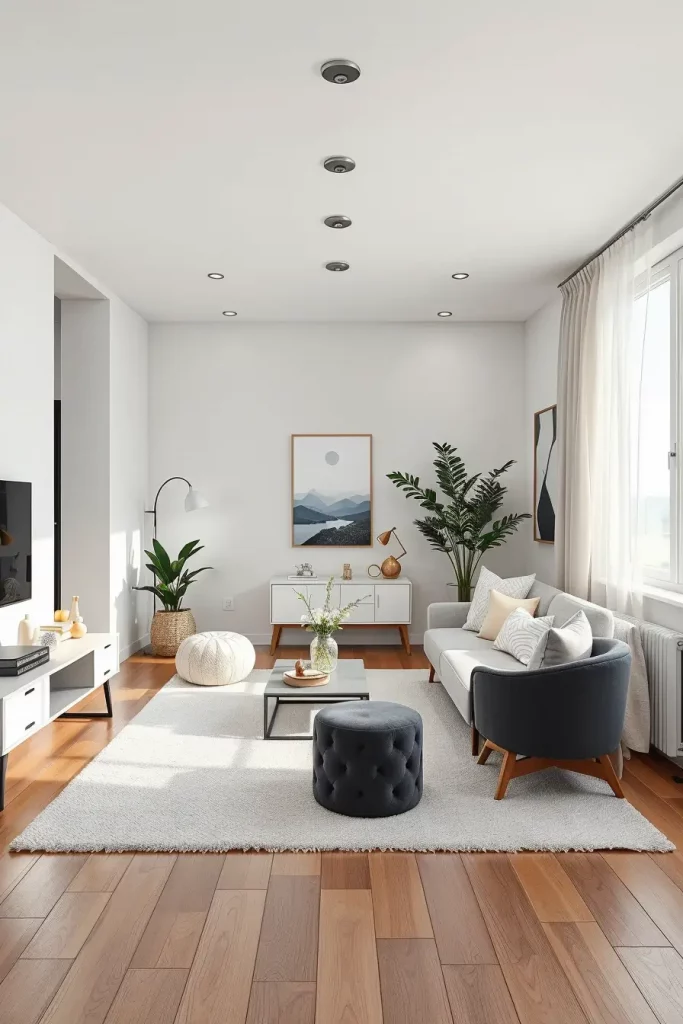
From what I have seen, using only one color makes the space calmer and it feels wider. Architectural Digest’s interior designers say that picking just one color family helps unify the space, making it appear bigger.
Something that would make the space stand out more could be an armchair or throw in a darker shade of gray.
Add Warmth With Soft Lighting
Good lighting can completely change a little space and putting up nice, cozy light bulbs can give a small living room a glamorous look and make it comfortable. Instead of just using overhead lighting, mixing up your lighting can make the room feel totally different and more useful.
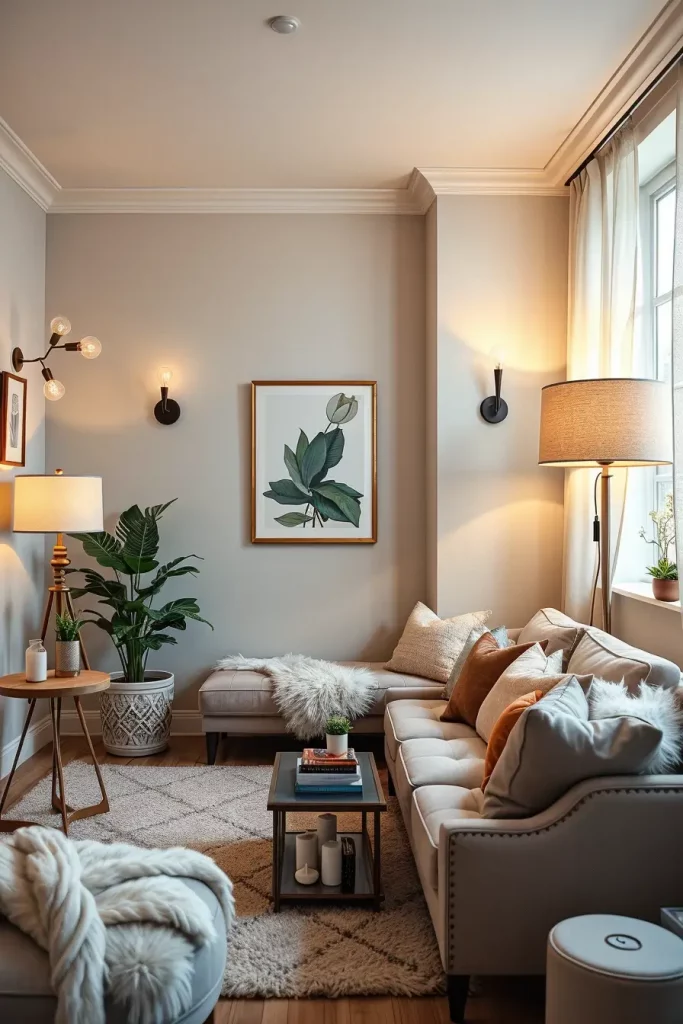
I include both table lamps, wall sconces and floor lamps and all of them use warm white bulbs that are around 2700K. Having dimmer switches allows you to adjust the mood of your room from day to night. Having glass or fabric shades in your lamps makes the room seem softer instead of highlighting its corners.
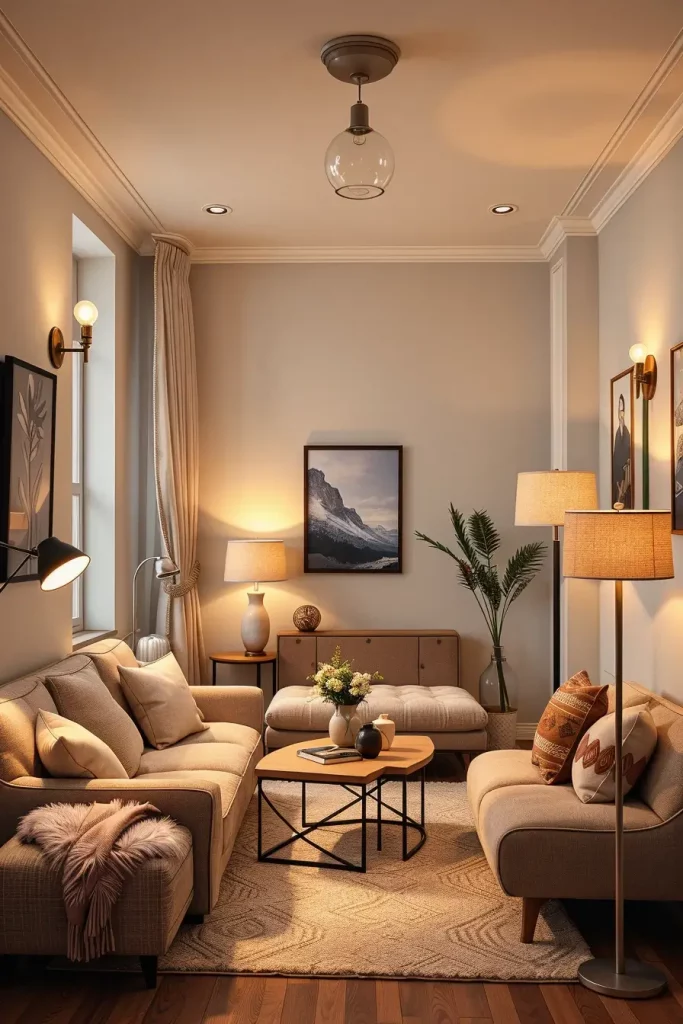
At home, I achieved this by installing different lighting layers which separated the room into zones for reading or conversation. As noted in Better Homes & Gardens, lighting should be designed to fit the size and scale of any room, but especially in smaller ones.
What we often forget is to truly use the height of the room. Placing a pendant with a fabric diffuser above the table could both refine the room and become a unique centerpiece.
Mix Modern And Vintage Accents
Adding a combination of modern and vintage items can help a small living room look organized and special to you. With this method, you can combine modern style with vintage pieces, resulting in a texture that isn’t seen very often.
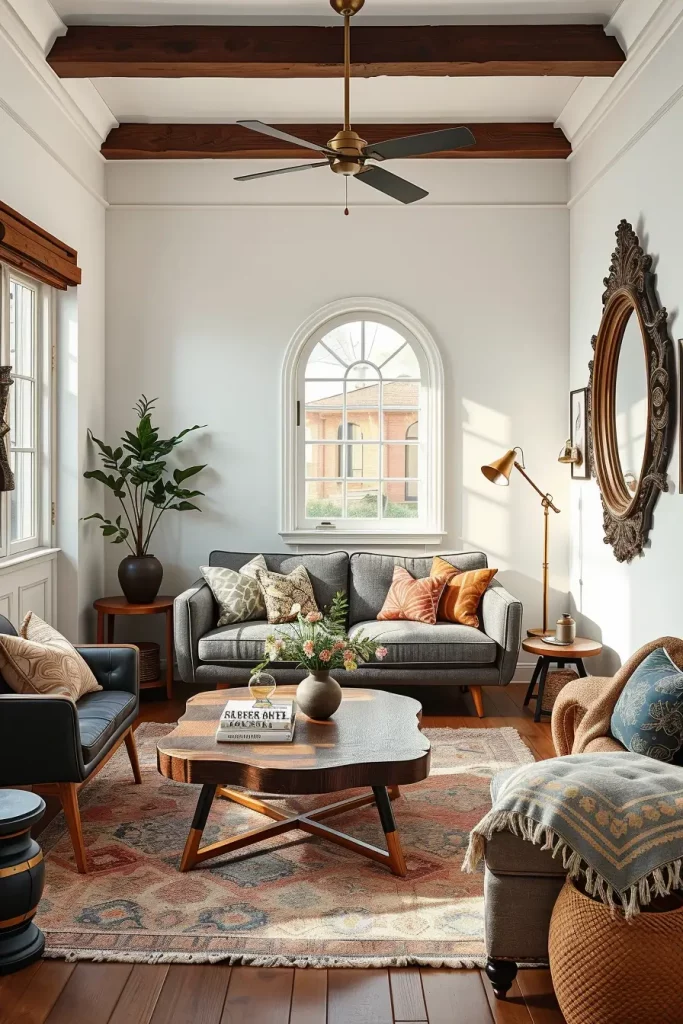
I enjoy putting a mid-century modern sofa with either a vintage coffee table made from wood or an antique mirror. A combination of brass and matte black in your decor will give your room contrast without being overpowering. All these pieces add texture, history and uniqueness to your cozy home.
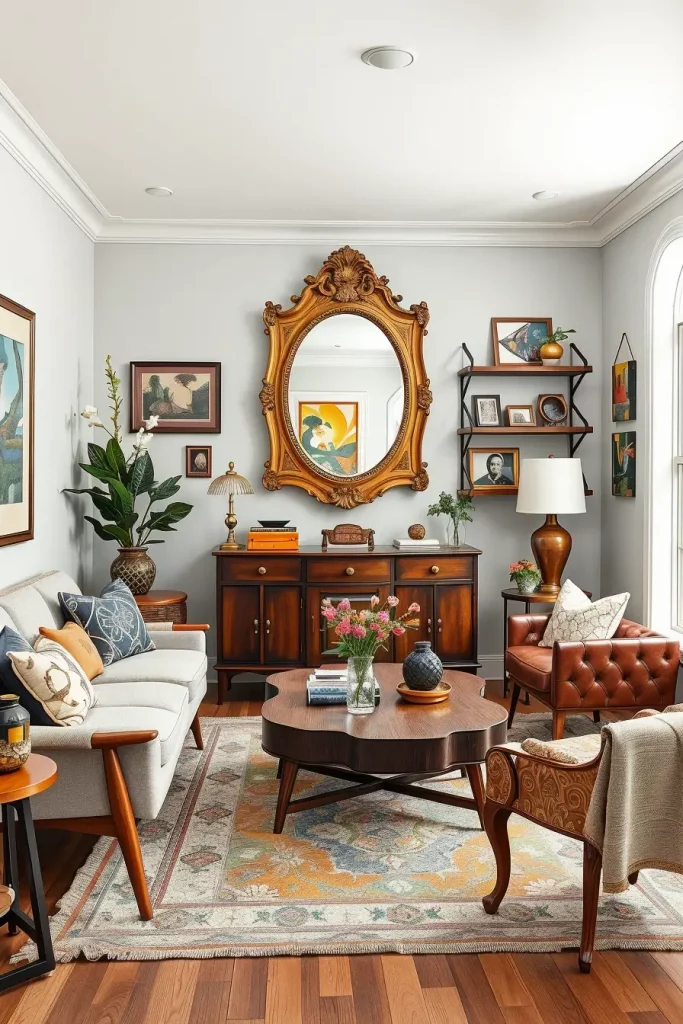
Moving different designs together keeps things interesting in my rooms. Emily Henderson Design believes that including vintage furniture in a modern home creates comfort and interest.
An essential aspect missing here is the same finish throughout a house. You should stick to only two to three metallic shades and pair heavy old-style with light modern metal pieces to keep the arrangement looking organized.
Elevate Corners With Corner Shelving
In most cases, the corners in small living rooms are wasted. Labelling corner shelving is a stylish way to get both space to display and to store while leaving the floor unoccupied.
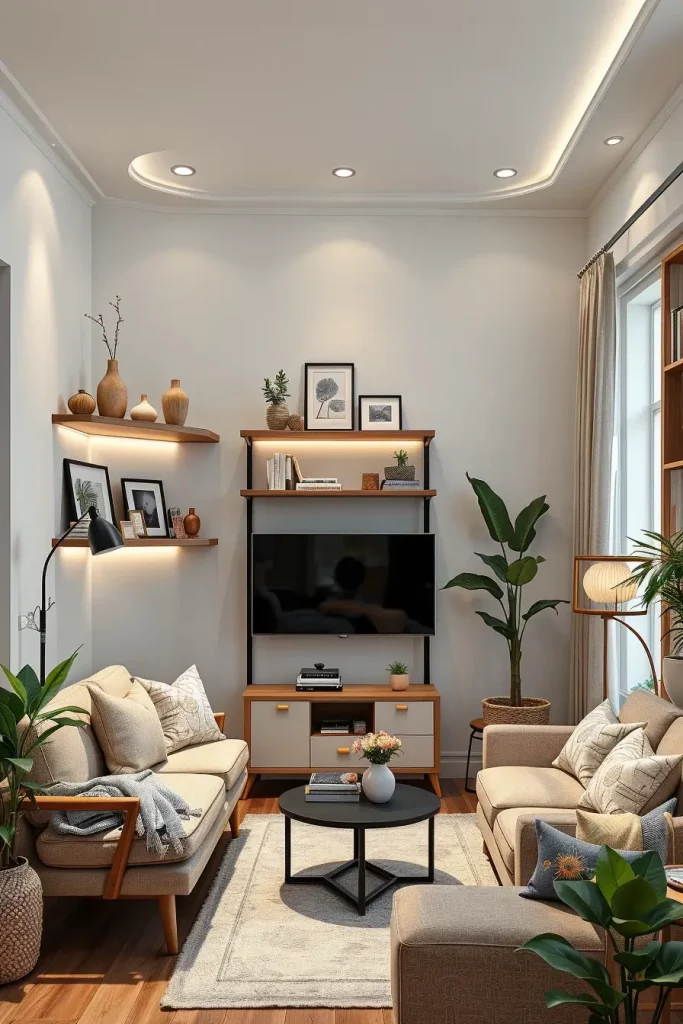
Many times, I set up floating corner shelves to display my collection of candles, books or little plants. Ladder-style corner unit can give a space more height and organization. Having too much styling can make any space feel cluttered, so try to keep your design simple.
Using thoughtful design to fill a corner, I’ve noticed it can turn blank space into something special. Corner furniture is a great way to add useful elements to a room, according to HGTV experts.
Introducing integrated lighting to our indoor smart home would be great. Placing an LED strip under the bottom shelf makes your shelves appealing and can be used as soft lighting.
Transparent Furniture To Reduce Visual Clutter
Adding furniture made from acrylic or glass can open up and lighten your creative small living room. These pieces give you everything you need for your cupboard while letting sunlight come through which helps make your room feel more spacious.
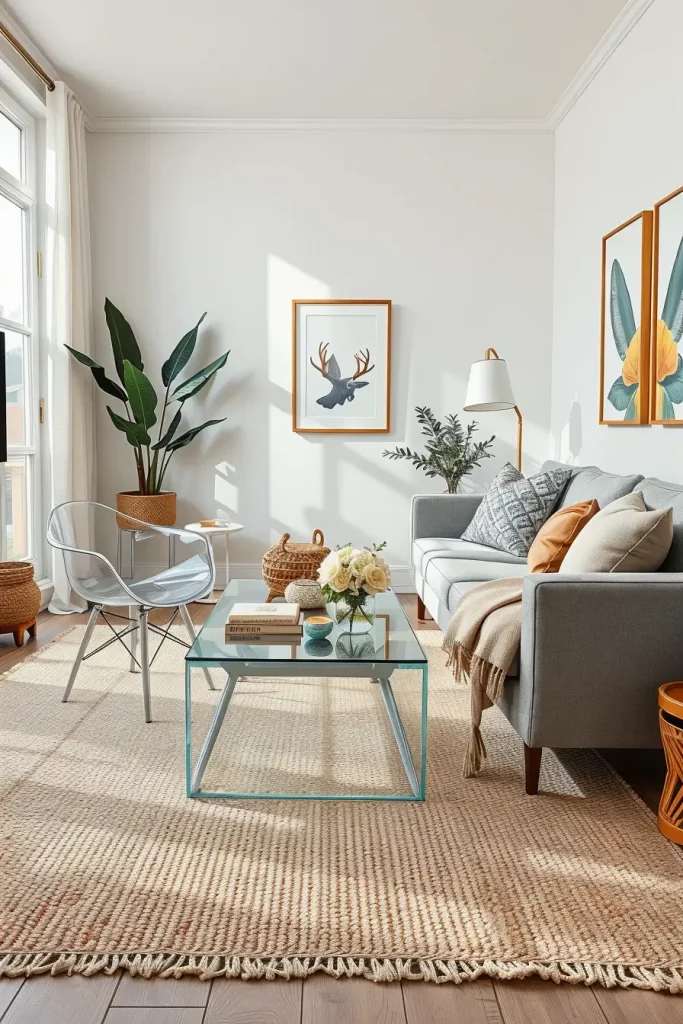
I find that it’s better to put a simple coffee table or side table with dark seating or heavy fabrics. These works seem empty in a good way which helps make the space feel lighter. Having a ghost chair in the corner means you have somewhere to sit that won’t take up much room.
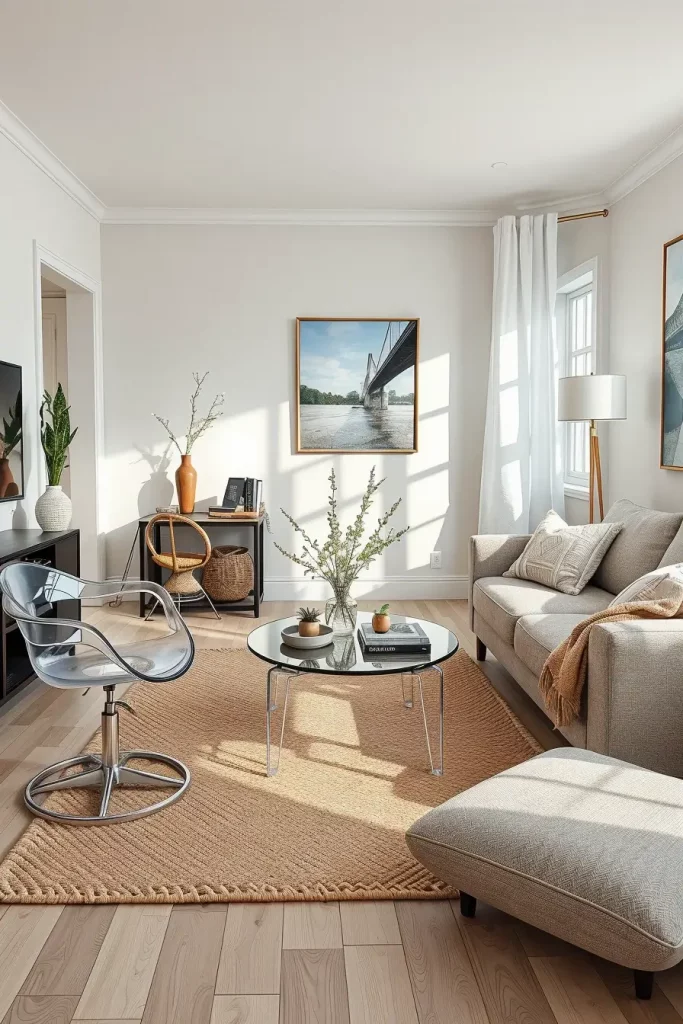
In rooms where space is limited, I’ve used an acrylic console to keep items nearby and still be able to see around the room. It is noted in Domino Magazine that clear furniture adds visual space to any little room.
Often, a lack of contrast between smooth and tactile surfaces can give a decor scheme the wrong, characterless feel.
Maximize Natural Light With Sheer Curtains
Letting natural light enter is central to good small living room planning. Light shines through sheer curtains and softens its impact so the place appears both brighter and larger with less brightness as a problem.
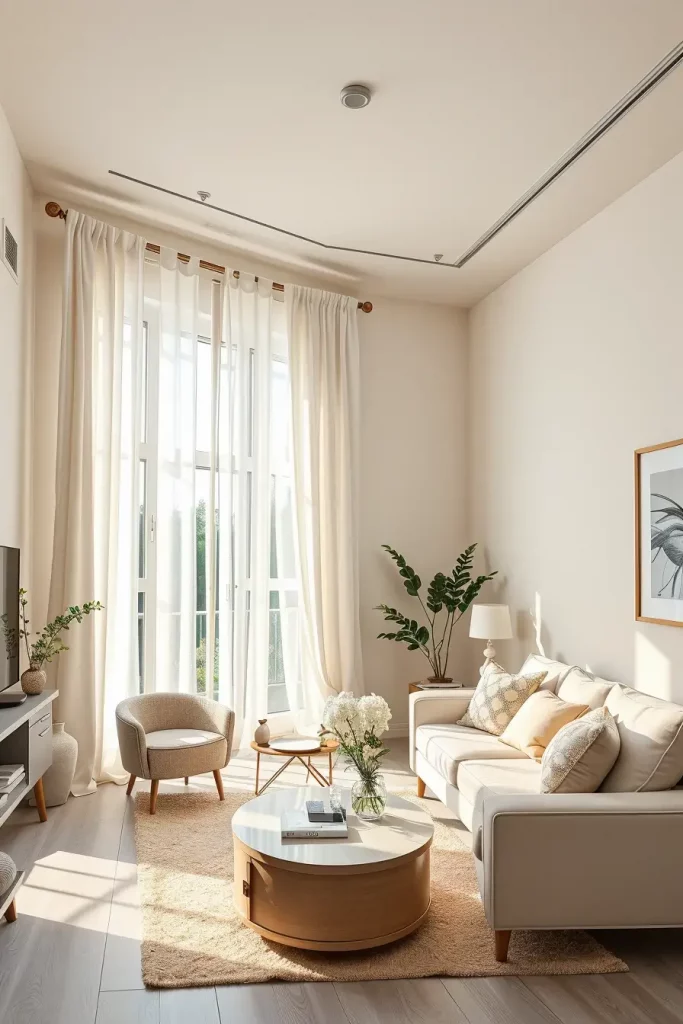
White or cream lightweight curtains, hung on rods that stretch past the window frame, are what I normally select to make the room look wider. Even if a room has little natural lighting, sheer panels can give it a finished appearance and help keep it light.
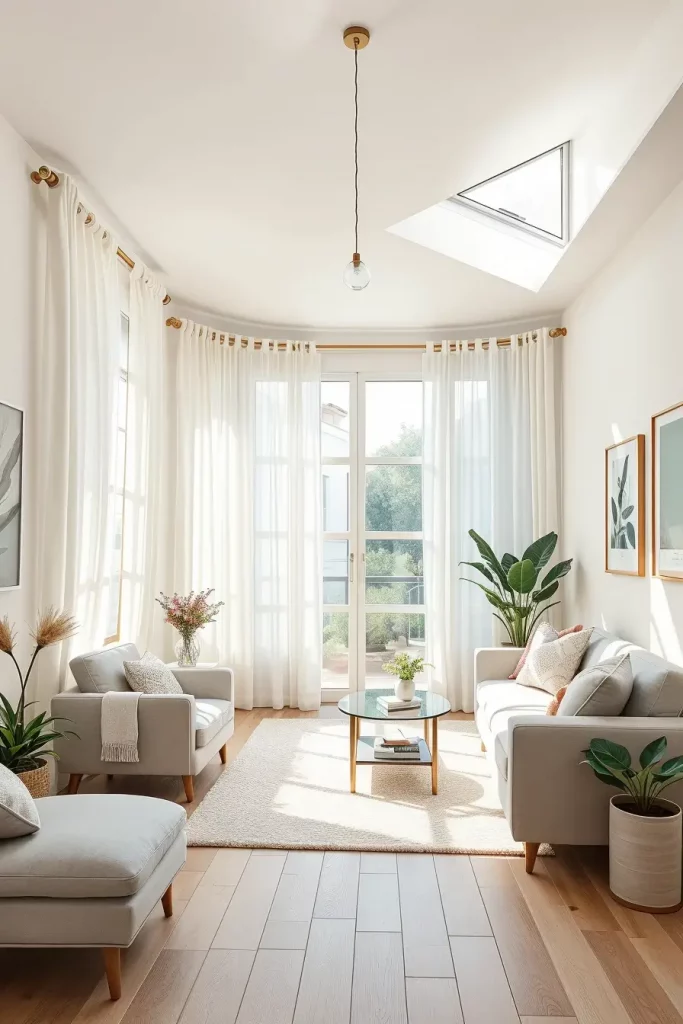
I find that using only natural light improves the appearance of every piece in the room. According to Apartment Therapy, you should pick the lightest fabric you can in small apartments to create a more spacious and airy look.
A good way to build on this concept is by adding layers. Put up two rods and have blackout curtains behind the sheers so you get night privacy and day brightness at the same time.
Add Dimension With Layered Lighting
With layered lighting, the special quality of soft light is created by linking different types of lights placed at various heights. This way of designing helps make a little space more useful and interesting.
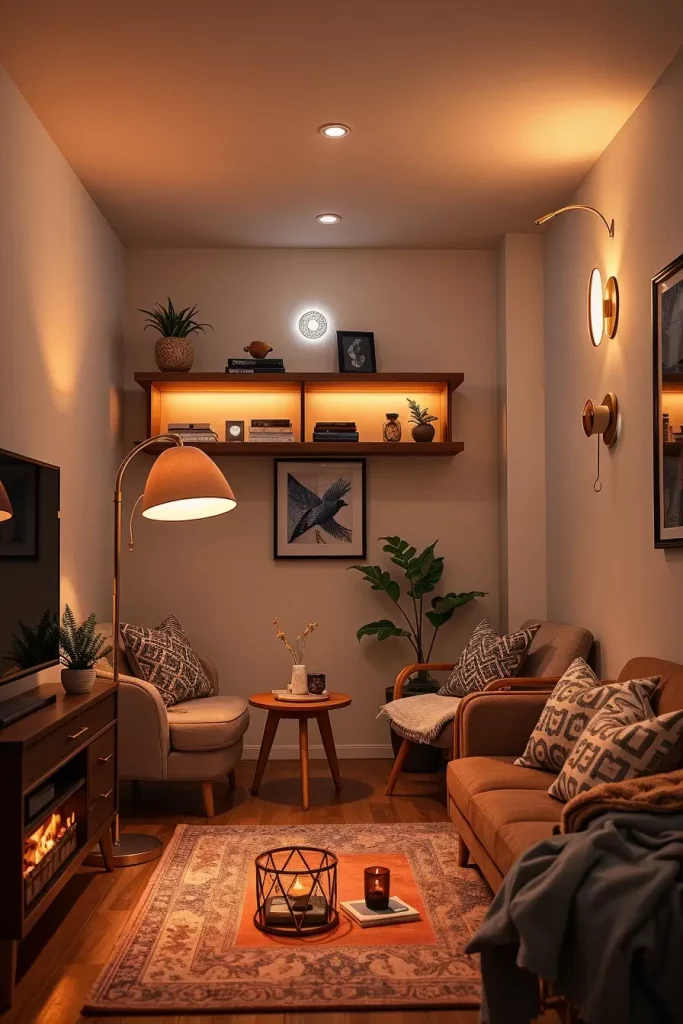
I have floor lamps, table lamps, sconces and at times use LED strips on shelves or behind furniture. Every source is chosen for either task, ambient lighting or as an accent and helps to make the design warmer and more interesting.
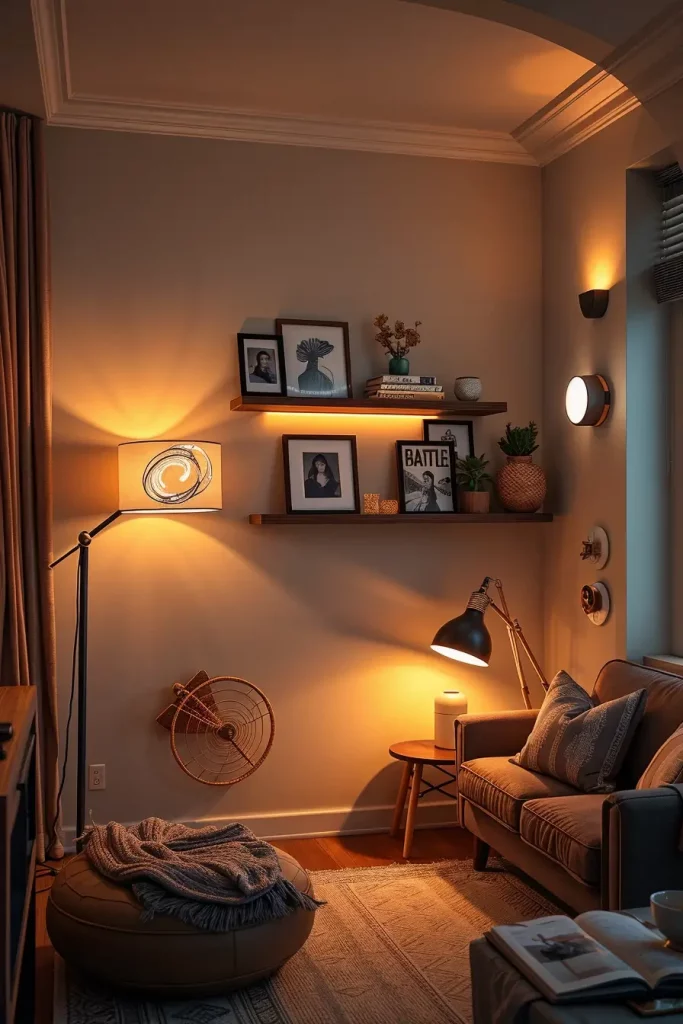
I find that using several layers of lighting makes it simple to combine practical use with attractive lighting. Houzz explains that adding three lights in each room makes the atmosphere better which is very useful in tight spaces.
What is usually left out in these designs is ceiling lighting design. You may try recessed lights you can dim or a chandelier with a soft bulb to complete the look.
Choose Artwork That Reflects Your Personality
Starting with characterization is the first thing I do when planning a small living room. Art is the quickest and most reliable way to give personality to any space. I prefer pieces that reflect the owner’s experiences, travels, or passions. A small area can be made both attractive and interesting by the right choice of art, without appearing crowded. Whether it’s one large canvas or a gallery wall, the key is balance and meaning.
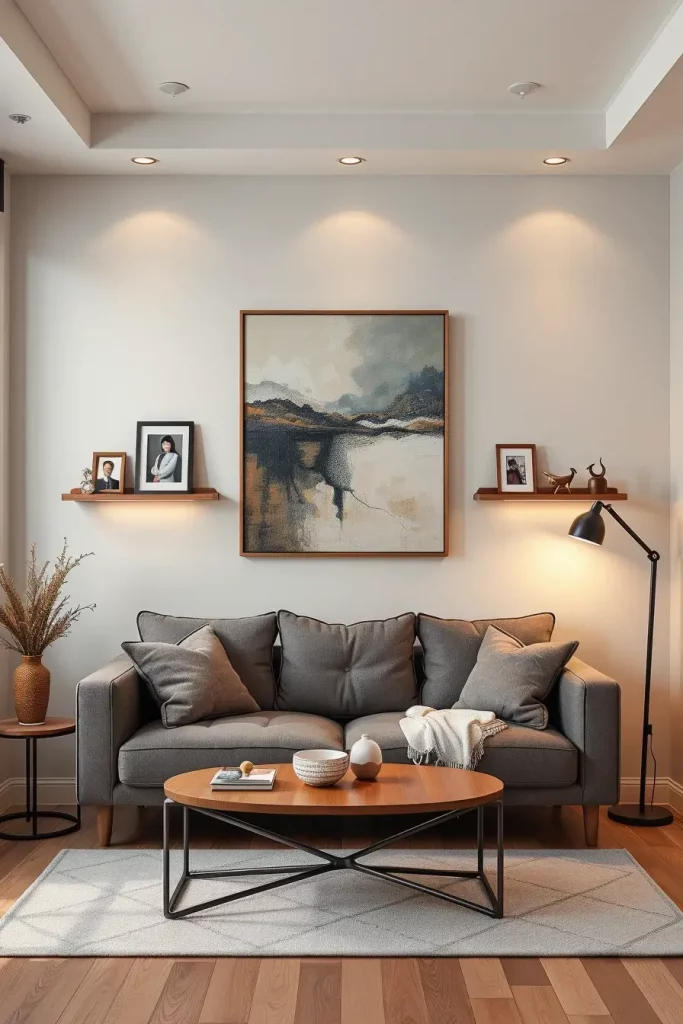
It’s something I often recommend: putting a large abstract or photographic print above your sofa. It leads your sight higher and gives the room its center of attention, all by itself. You can always display framed photos or colourful line art works too. Rotating art on floating shelves is perfect for people who need to refresh their decoration several times a year.
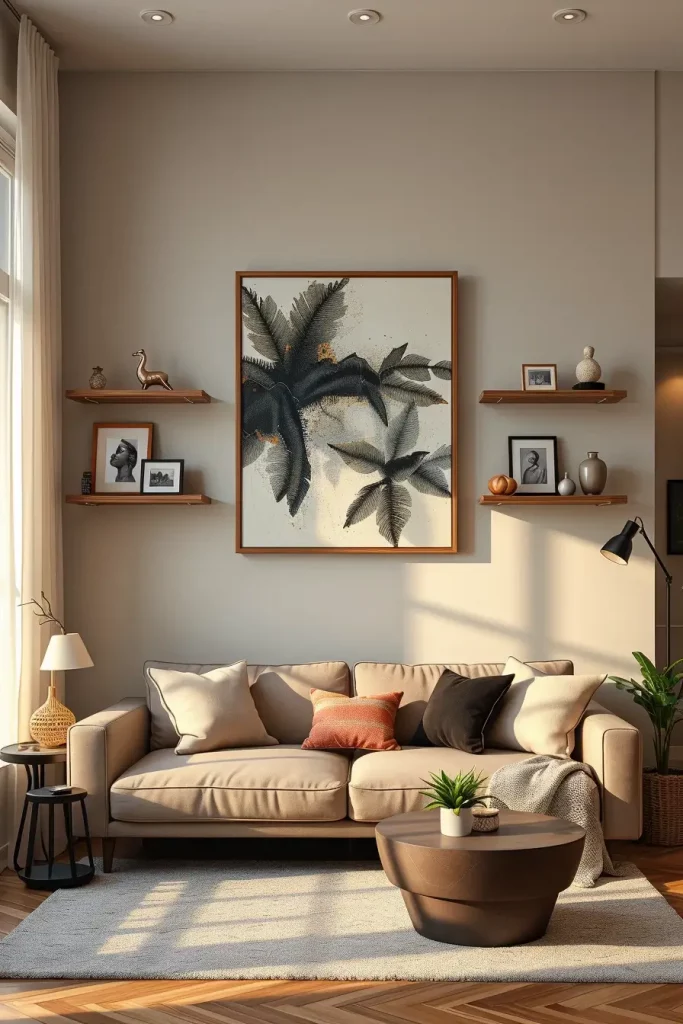
In my experience, selecting suitable artwork has a softening effect on a small living space. As Apartment Therapy reports, the correct placement of a bold art piece can actually help a space feel more spacious. I recommend my clients add color and story to their spaces as it helps the room seem real and lived-in.
I would also like to recommend color combinations for art and its surroundings. Alternatively, exciting prints on white walls or neutral tones set against a subdued color, can make the area more noticeable.
Creative Layouts For Awkward Spaces
It is very satisfying to design rooms that are not very big. I’ve created L-shaped, thin and triangular rooms by rethinking their layout and optimizing the useful areas inside. The main thing I look at is how the space will serve its functions every day.

I prefer to place a small sofa right in the center to create a barrier between the lounge and entry area, in open-plan apartments. Choosing round coffee tables and L shaped or loveseat sectionals lets you move around the room easily. Adding rugs to a place always makes me see how all the parts connect and provide visual continuity.
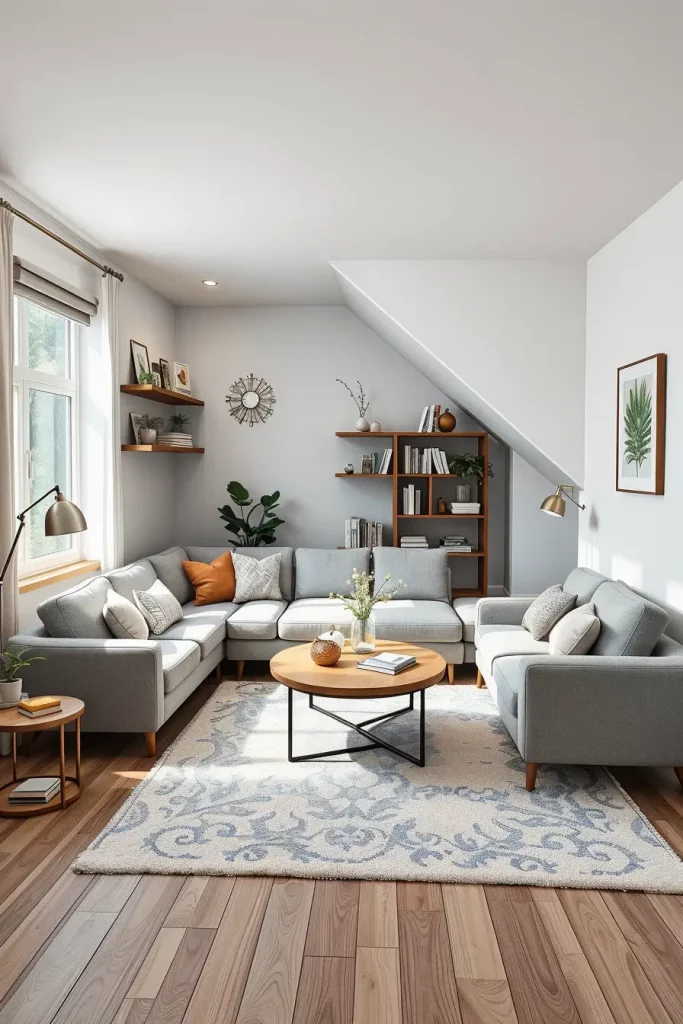
For me, tackling awkward rooms is what makes your home unique. A customer once asked me to make a reading nook from an awkwardly slanted corner and we achieved it using a curved chair and bookshelf. In Emily Henderson’s words, don’t aim to hide your individual traits; build your design to match them instead. Take advantage of different heights and patterns for your outfit.
Adding more figures and illustrations in this section will help explain how to rearrange furniture to bring out the best features in any space.
Keep It Clutter-Free With Hidden Storage
Clutter can grow very quickly in a small living room. That’s why I always emphasize hidden storage. I try to find furniture that can perform more than one function, for example, ottomans that store things and coffee tables that have drawers. The process of storing things should be built into the design, not just tacked onto the end.
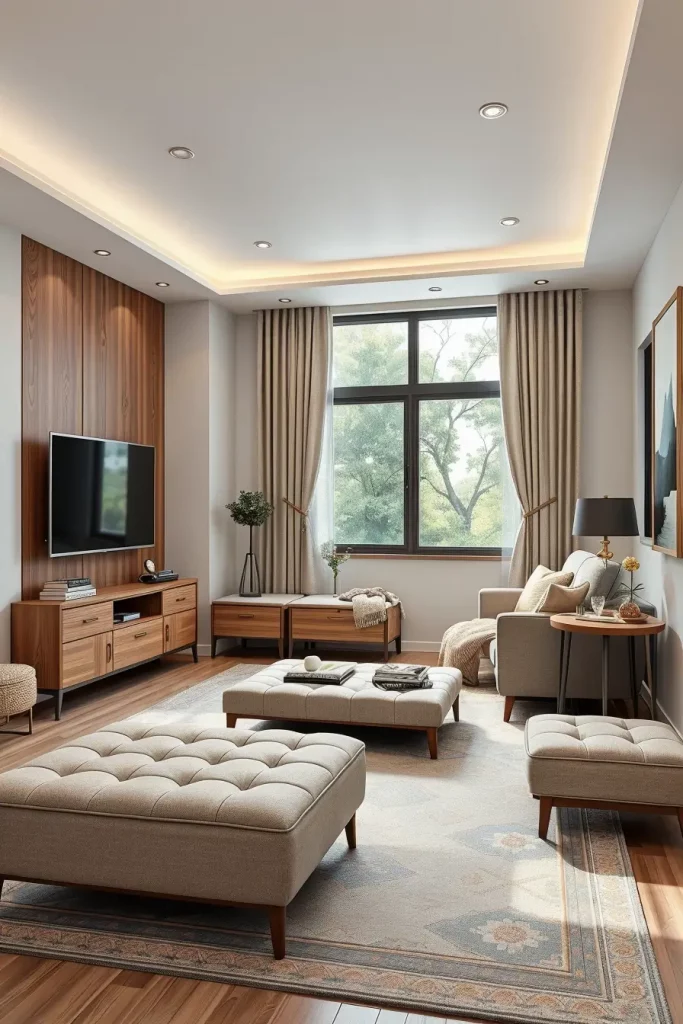
I prefer TV wall units with sliding doors or tables that have hidden drawers. Many of my clients choose a bench seat under a window that opens using lift-up lids. Stylish baskets kept under open shelves help keep your space organized. Wearing pieces in neutral colors brings together your outfit, making it uncluttered.
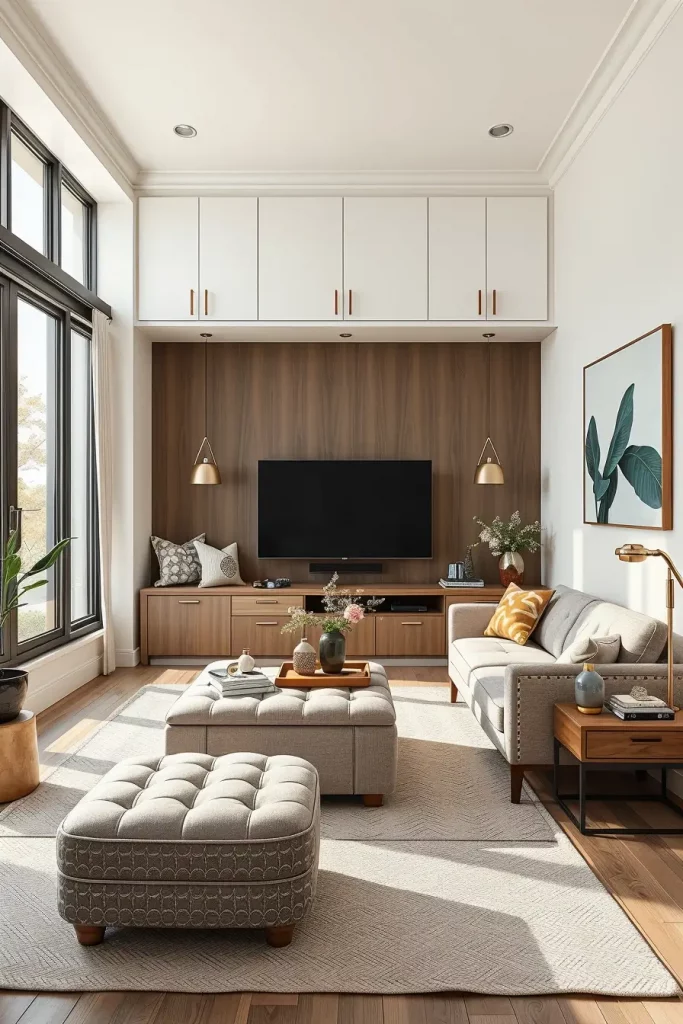
I have found that a room without clutter appears to be larger right away. Recently, I advised a couple who put up floating cabinets above their sofa in a color that matched their wall. This made the cabinets look neat and useful. Following Real Simple’s advice, using wall space from top to bottom is important in any small home.
Additionally, I recommend covering secret tech solutions like office cable organizers that are built into the furniture and desk workstations with foldable surfaces for working at home in small apartments.
Personal Touches For A Unique Small Living Room
Even when living space is limited, your living room should make you feel comfortable and relaxed. Adding personal items such as fabrics or passed-down objects, gives a room character. You might want to start by buying or making something handmade, for example, a crocheted throw, a vintage lamp or a wall hanging you’ve handwoven. These little accents give a small space unique character.
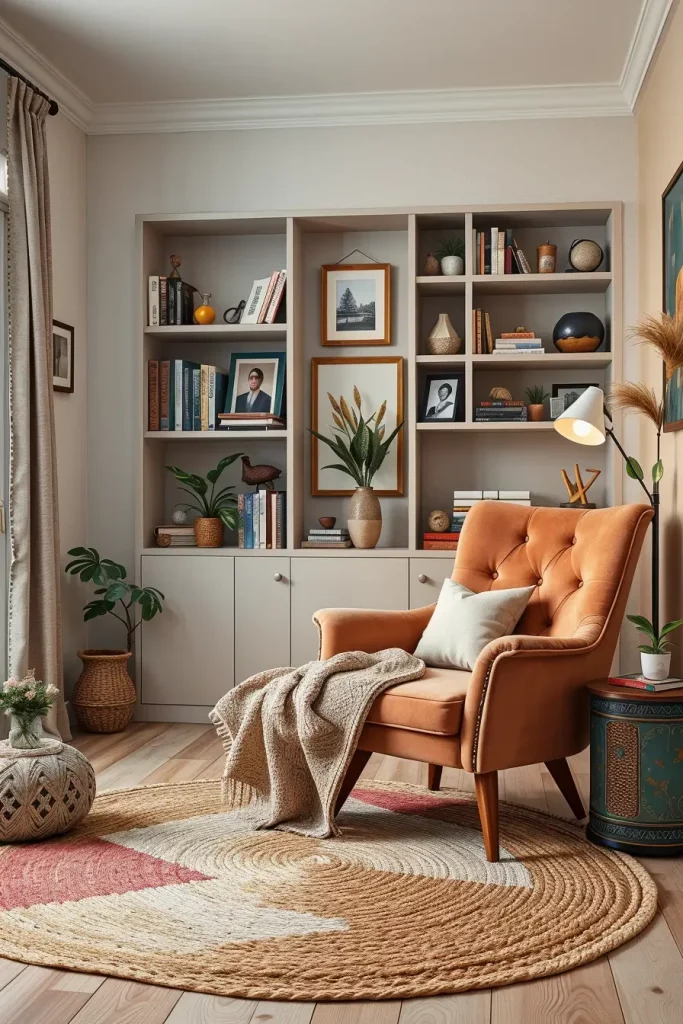
A method I rely on is adding various types of textures to a surface. Having a boucle cushion on a velvet chair, plus a jute rug, gives the space a friendly touch. A floating shelf, used to showcase personal trinkets in small groups, works well also. Decide on colors that express that mood you have—softer tones for peace, stronger colors for passion or life.
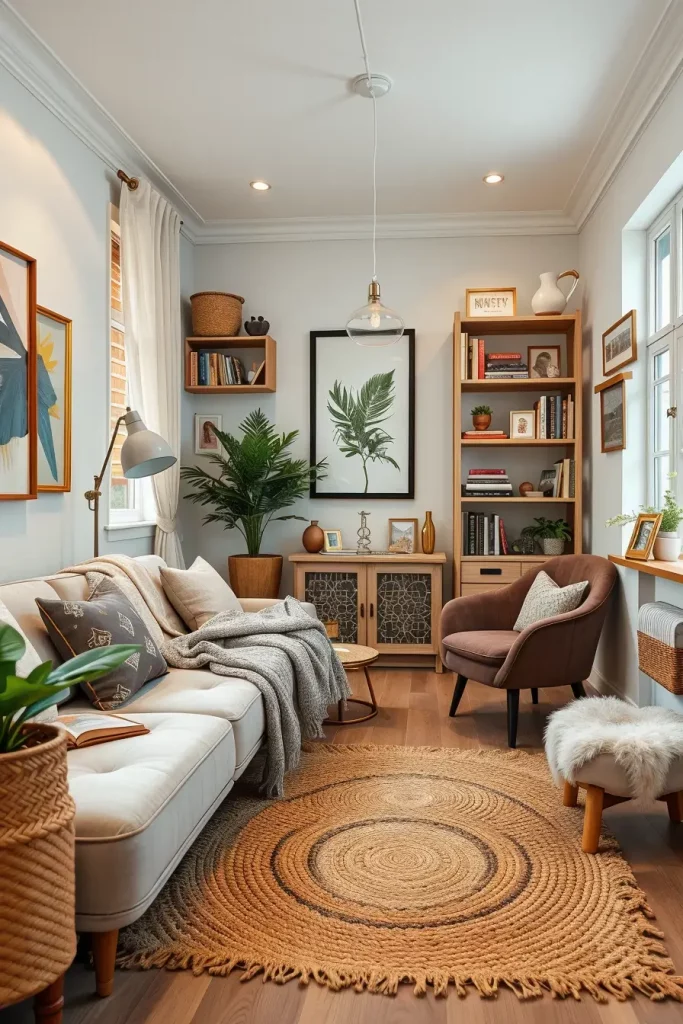
I’ve made a display in my home using books and little trinkets to show off my travel and hobbies. Nate Berkus, a design expert, sees a room that doesn’t reflect you as no more than a showroom. I truly believe that this concept drives my work on every design project.
Adding simple ideas such as changing the pillows and posters throughout the year, could make this topic more appealing.
Having a small living room doesn’t have to mean losing style or comfort; all that’s needed is a little imagination. All the choices you make, from cute art to useful furniture, can help your indoor space shine. Have a great way or any suggestions for making small spaces work? I’d love to hear your thoughts—feel free to share them in the comments below!
